Now expanded, revised and updated to April 2017
Richard Honeck (1879-1976), an American murderer, served what was, at the time, the longest prison sentence ever to end in a prisoner’s release. Jailed in November 1899 for the killing of a former school friend, Honeck was paroled from Menard Correctional Center in Chester, Illinois on 20 December 1963, having served 64 years and one month of his life sentence. In the decades between his conviction and the time his case came to public notice again in August 1963, he received only a single letter – a four-line note from his brother in June 1904 – and two visitors: a friend in 1904, and a newspaper reporter in 1963.
Honeck, a telegraph operator and the son of a wealthy dealer in farm equipment, was 21 years old when he was arrested in Chicago in September 1899 for the killing of Walter F. Koeller. He and another man, Herman Hundhausen, had gone to Koeller’s room armed with an eight-inch bowie knife, a sixteen-inch bowie knife, a silver-plated case knife, a .44 caliber revolver, a .38 caliber revolver, a .22 caliber revolver, a club, and two belts of cartridges. They also carried a getaway kit: two satchels filled with dime novels, obscene etchings, and clothes from which the names had been cut (New York Times, 4+5 September 1899).

Richard Honeck before and after: mugshots taken at the time of his arrest (1899) and his parole (1964).
Koeller, who was later found by the police sitting in a chair stabbed in the back, had testified for the prosecution some years earlier when Honeck and Hundhausen were charged with setting a number of fires in their home town, Hermann, Missouri (New York Times, 5 September 1899). According to a confession made by Hundhausen, the two men had sworn revenge and had planned Koeller’s murder in considerable detail. Honeck, Hundhausen said, had stabbed the dead man with the eight inch bowie knife (Ibid and Chicago Tribune, 5 September, 22+25 October, 5 November 1899).
It was left to a latter-day Associated Press reporter, the memorably-named Bob Poos, to shine a spotlight on Honeck’s case in 1963 after seeing a reference to it in the Menard prison newspaper. Poos noted that after his initial article was published in the papers, the aged murderer received a mailbag of 2,000 letters, including a proposal of marriage from a woman in Germany, offers of employment, and gifts of money in sums ranging from $5 down to 25 cents. Honeck, who was permitted under prison rules to answer one letter per week, observed: “It’ll take a long time to deal with these.”

Clara Orth shows Honeck the scrapbook she had assembled filled with news stories about him, December 1963
Honeck spent the first years of his sentence in Joliet Prison, where in 1912 he stabbed the assistant warden with a hand-crafted knife. He served 28 days in solitary confinement for that infraction, but had a clean record after moving to Menard, where he worked for 35 years in the prison bakery. “I guess I’d have to be pretty careful if I got paroled,” the old lag concluded when interviewed by Poos. “There must be an awful lot of traffic now, and people, compared with what I remember.” (Chicago Tribune, 25 August and 27 October 1963.)
Poos got the chance to find out whether he was right when he accompanied the “sprightly” 84-year-old Honeck after his release as he was escorted to St Louis airport to catch a flight to San Francisco. “The old man,” he wrote, “was visibly amazed at the progress that had passed him by while he sat behind prison bars. During the car trip from Chester to St Louis, Honeck said, ‘Why, we must be going 35 miles an hour.’ The driver, Warden Ross Randolph, answered, ‘Actually, Richard, we’re going 65.’ Later, on the jet, Honeck remarked, ‘I travelled faster in that car today than I ever had in my life, and now we’re going almost 10 times that fast – and six miles up in the air, too.’”
Honeck was met at San Francisco airport by his niece, Mrs Clara Orth, who had been alerted to his extraordinary story by Poos’s original news report. She had quit her job to care for her uncle, selling her one-bedroom trailer home and buying another in Oregon which had two bedrooms for them (St Petersburg Evening Independent, 27 December 1963 + Tuscaloosa News, 1 January 1964).
Orth – who was Honeck’s sister’s daughter – had some family memories to recount as well. Her mother had died a couple of years after Honeck went to jail, and her widowed father sent her to Hermann to live with her grandfather, Honeck’s father, and an aunt. In six years in Missouri, Orth recalled, “Uncle Richard’s father and sister never once mentioned him.” Interviewed again at the time of Honeck’s death, Orth said that her uncle had slowly become senile and had to be placed in care. “He wasn’t bitter,” she added. “He decided long ago that if he had to be in prison that he would make the best of it. Since he got out he’s had a glorious time.”
Richard Honeck was the first prisoner to attract widespread media attention simply because of the length of time he’d served. He lived on for more than a decade after his release, dying at the age of 97 in an Oregon nursing home ( St Petersburg Times, 30 December 1976). But while his record-breaking stretch probably was unique in its day, the 64 years plus change he served has since been exceeded at least eight other cases…
Coming up:
[1] In depth: Charles Fossard (70 years, the current world record-holder) and “Old Bill” Wallace (63 years; died, still incarcerated, aged 107)
[2] In depth: The case of Paul Geidel (68 years)
[3] In depth: The case of Van Dyke Grigsby (66 years and a Johnny Cash song)
[4] In depth: The case of Frank Smith (67 years and the current longest-serving man)
[5] In depth: The case of Howard Christensen (64 years of being obnoxious)
[6] Longest spells in solitary confinement
[7] State-by-state capsule studies of longest sentences served, featuring ‘Crazy Jimmie’ Williams, Leslie van Houten and the Manson Family, ‘Old Fitz’ Fitzgerald, the Lipstick Killer, the Starved Rock Murderer, Warren Nutter, the Boston Boy Fiend, bestiality in Missouri, death row poetry, the Kitty Genovese case, and a mid-sentence West Coast road trip for West Virginia’s leading badman…
[8] Longest sentences served outside the U.S., featuring the Kissing Point Mutilation Murder, bride purchasing in Denmark, the Man in the Iron Mask, and Ian Brady…
[9] Jouanna Thiec and the Huguenot connection
[10] Listing of all inmates with in excess of 60 years served
[11] Methodology, sources and comments
Richard Honeck was the subject of significant press interest at the time of his parole. Below is a gallery of press photos made available at the time of his release. Click on any image to view it in higher resolution.
Charles Fossard and the Australian connection
Sifting through the vast mass of material accumulated in the course of the research for this essay, it becomes clear that one factor, above any other, increases the chance that prisoners will serve out vastly lengthy sentences: the diagnosis of a mental illness. Being sent to a secure hospital, rather than a prison, means that a convict is likely to enjoy more comfortable conditions, or at least a considerably laxer regime, than he would do if he was in prison. But it also places him beyond the reach of the parole system, and there’s often a presumption that somebody deranged enough to have committed violent crimes might do the same again if they are ever released – irrespective of their doctors’ judgement. Certainly there are cases of prisoners who were eventually judged sane by those charged with caring for them who nonetheless remained behind bars, whether for political reasons or simply to guarantee public safety.
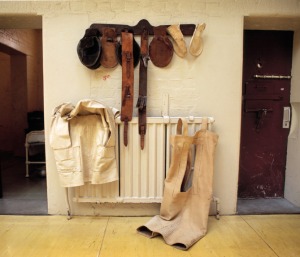
Restraints, much used in Fossard’s time, displayed inside J-Ward, the Australian state of Victoria’s secure mental facility in Melbourne. Photo by Darren Ward.
Combine mental illness with a major crime committed in a felon’s youth, then, and you have the recipe for an exceptionally long spell inside. That is certainly true of the inmate who seems to have completed the longest sentence ever served: Charles Fossard, a French immigrant to Australia who killed a man in Skye, just south of Melbourne, on 28 June 1903. Fossard (no doubt originally Foussard) was then just 21 years old; he was tracked down, interrogated, judged insane, and then incarcerated on 21 August that same year. Sent on to the grim secure hospital known as J-Ward, part of Melbourne’s Ararat Lunatic Asylum, he remained there until his death, aged 92, on 19 June 1974. All told, that meant that Fossard served out very nearly 71 years inside – and served them in a place that even the notoriously tough Australian criminal Mark “Chopper” Read observed was “a terrible place. There was a shit bucket in the middle of the room. People slept on the concrete floor. Meal times were like the feeding of animals. Some people couldn’t have their straightjackets removed, they were that mad. So people still wearing their straightjackets would just dunk their heads into the bowls of food.”
As for the crime that put him there: the “Skye Tragedy”, as contemporary Australian newspapers referred to the killing, was distressingly banal. Fossard, a former sailor who had jumped ship at Sydney three years earlier, was a vagrant down on his luck when he shot and killed an elderly man named William Ford after Ford turned him away from his home. He was caught two weeks later, still wearing his victim’s old boots.

The 1989 funeral of Bill Wallace, who died, still incarcerated, one month shy of his 108th birthday.
While youth and mental illness are a potent pairing, though, J-Ward records also contain a single example of a far rarer combination of circumstances: mental illness and extreme old age. Bill Wallace was 46 when he shot dead a man named Ernest Williams during an argument over a cigarette in a Melbourne cafe in 1926. In normal circumstances, his age alone would have been enough to deny Wallace a place on this listing. But old Bill was far from normal. He lived on, and on, dying only after serving more than 63 years inside. He was by then just one month shy of 108 – the oldest prisoner by far of whom I’ve found a record.
Further memories of J-Ward in Bill Wallace’s time are provided by the prison’s former pastor, Gordon Moyes, who visited during the 1960s, and they give some idea of the sort of conditions that the old prisoner experienced as he lived into his second century:
On my first day in Ararat I was given a massive iron key to open the thick, heavy, iron and wood doors to the maximum security division to enable me to visit cell to cell the psychotic prisoners… J Ward was built last century of heavy blocks of blue granite with high walls topped with rolls of barbed wire. Every gate and window was barred with steel bars one and a half inches thick.
The prisoners were considered the most dangerous in the country and the people in the community looked up to the top of the hill where the psychiatric prison stood like a great castle, fearful of the night when the sirens might go announcing a mass escape when they would all be murdered in their beds. There was no love for those prisoners in Ararat.
The prisoners I met as I went from cell to cell or stopped and talked to in the exercise yard were a strange mixture. They were the insane murderers of Victoria marked “Never to be released” or “To Be Held At The Governor’s Pleasure”. There was a man who constantly barked like a dog, and another man who would ask you frequently if you had ever sawn a man up into small pieces with a wood saw as he had.

Old Bill Wallace, the thick end of his way through spending 64 years in Australia’s most infamous insane asylum.
It’s worth asking why a man of 107 continued to live in such surroundings. The truth seems to be that Bill Wallace was the perfect exemplar of the long-serving mental patient. Had he been an ordinary prisoner, it seems probable, he would have secured parole well before his hundredth birthday – being judged unlikely to pose any sort of danger to his community. And as a heavily-monitored inmate of J-Ward, he was surely by that point unlikely to commit further crimes. But he was beyond the reach of normal prison systems, and had become institutionalised in the one place most likely to keep him alive, and equipped to keep him confined – an institution that, as “Chopper” Read observed, was not merely “a dank legend in the minds of men who have been in it,” but also “a bit like the Australian cricket team. It was harder to get out of than get into.”
The case of Paul Geidel
When Richard Honeck was released, Paul Geidel was already more than 50 years into his own sentence for a second-degree murder. He went on to surpass Honeck’s record, and eventually served 68 years, eight months and a day in various New York state hospitals and prisons.
Geidel had been only 17, and working as a bellhop at New York’s high-toned Iroquois Hotel, when he broke into the apartment of the rumoured-to-be-wealthy William Jackson, 73, and killed his victim by choking him with a chloroform-soaked rag. It was harder than he expected – “The old man put up a fight,” he said – and he got away with nothing but $7 in cash, a watch and a stickpin in exchange for Jackson’s life.
That was in September 1911, and Geidel was finally released on 7 May 1980, at the age of 86. His case differed from Honeck’s in two key respects. Firstly, he was initially sentenced not to life imprisonment but to twenty years to life, being later declared insane and moved to a hospital for the criminally insane. Secondly, Geidel was offered parole at an earlier date than was Honeck – in 1974, when he had served only 62 years. By then, he had become institutionalised and he declined release, voluntarily choosing to remain confined for an additional six years.
I take a special interest in his story because of a strange coincidence: Geidel’s crime took place in an apartment next door to the one owned by Charles Whitman, who was New York’s district attorney at the time. Whitman, it is reported, took a personal interest in the case and “extracted a confession or two.” This comes as no surprise to me, since Whitman was also the politically-motivated prosecutor responsible for the arrest and execution of Charles Becker, a corrupt New York cop found guilty of the murder of a gambler named Herman Rosenthal in two notorious trials of 1912 and 1914 largely as a result of Whitman’s determination to hound him to the electric chair. The Becker case and Whitman’s behaviour in it were the subject of my book Satan’s Circus.
The case of Van Dyke Grigsby
Paul Geidel’s U.S. record for time served was for many years most closely rivalled by the case of – the in many ways vastly more interesting – Johnson Van Dyke Grigsby (probably February 1886-18 May 1987), of Jefferson County, Kentucky. Grigsby was convicted of second degree murder in 1908 and eventually paroled from Indiana State Penitentiary in Michigan City in 1974, having served 66 years, four months and one day (24,229 days, allowing for leap years) of his life sentence. He had been 56 years into that stretch at the time that Honeck was paroled, and was 89 when he was freed. His sole possessions at that time were a well-thumbed Bible, three old watches, a bottle of foot spray, and a packet of tobacco.
Grigsby entered the pen as prisoner 4045 on 8 August 1908 – having travelled cross-country for several days in a horse and cart to get there – and was freed on 9 December 1974. He had been convicted of knifing a man named James Brown to death in a saloon in Anderson, IL, on 3 December 1907.
The fight broke out over a game of five card stud poker. As Grigsby remembered it, “I never should have been sentenced to [serve a term for] natural life because that murder was more suicide than murder… I was in this saloon, just mindin’ my business, and this fellow comes up to me. I always wore a big diamond in them days. And he seen that diamond. Come up and said, ‘Wanna play some cards?’
“I had an ace, king, jack and deuce in my hand when he stood up and came at me. I had this little deerfoot knife that I pulled out and just cut him on the shoulder. He was bleeding, but so drunk he wouldn’t see a doctor… Stayed at the bar like a crazy man or something ‘stead of gettin’ to a hospital. He was a fool, is what he was… Just kept saying, ‘I don’t need no help.’ We even got a doctor to his house, but he went to bed and didn’t want no doctor.”
The victim, who was white, was found lying dead on his blood-soaked mattress the next morning, Grigsby added, and the sheriff who arrested him told him: “You couldn’t have picked a better one there, Van Dyke. He was a mean S.O.B.” In this telling of the story, Grigsby owed his sentence mostly to the machinations of a prosecutor who was running for the senate and wanted to look tough on crime; as he saw it, he had the last laugh, because although the DA who convicted him won the election, he was “dead in a year.”
At other times, however, Grigsby – who was the son of freed slaves – said that things had gone down rather differently. Brown had had a knife, he told the Kokomo Tribune, and he had grabbed it from him during their fight; on another occasion, he admitted that after the row erupted over the card table, he left the saloon and visited a pawn shop to redeem a knife that he had pledged there – thus establishing the premeditation necessary to justify a life sentence.
Research suggests that elements of all these various accounts combine to form the truth. Genealogist Reginald Pitts, who looked into the story and read the original sources, tells it this way: “According to the transcript of the trial, Mr Brown and Van were playing poker and started fighting. Curses and racial slurs were uttered, and Mr Brown pulled a knife on Van. Van left the bar, went home and got his own knife. Mr. Brown saw Van coming up the street back to the bar. He picked up a chair and threw it at Van, who dodged it, and then lunged at Mr Brown with his knife and stabbed him to death. Supposedly, the lawyer told Van to plead guilty to second degree murder in order to escape the electric chair.”
Grigsby seems to have been a model prisoner in the mould of the post-Joliet Richard Honeck. His main pass-times were reading the Bible (two of his three brothers were country preachers), an encyclopaedia and a dictionary. “That encyclopedia is an amazing book,” he said. “I read the whole thing from A to Z.” His other interest was boxing, and he reminisced frequently about the Jack Johnson-Jim Jeffries heavyweight title bout of 1910, although that had taken place a couple of years after he was imprisoned.
Like Paul Geidel, Grigsby became institutionalised during his long confinement, and spent a large part of his sentence under psychiatric observation – one source says nearly 50 years of it, another puts the time at 55 years. He found it difficult to adjust to freedom once it had been granted to him and he was sent to live in Woodview nursing home in Michigan City, where he kept mostly to himself and was described by staff as “moody” and friendless. He returned voluntarily to prison in 1976 after 17 months on the outside – a move he told one reporter he regretted – after complaining that life in his home was boring and that he had expected to be found a job “like being a porter in a barber shop… I could have done that, but there was no job. It was like being useless.”

Johnny Cash’s handwritten lyrics for the song Michigan City Howdy-Do sold at auction in December 2010, fetching $1,280. Click to view in higher resolution.
The old-timer was put up in the prison hospital because guards felt that, at 90 years old, he would struggle in the hurly-burly of the chow line, and he served a further several months there. His parole officer, John Rascka, said that Grigsby was a loner who preferred incarceration in the maximum security facility because it was all he knew and he was treated well. Most sources agree that he retained considerable vitality well into his 90s, maintaining physical fitness by dancing a “stiff-legged dance” of his own invention.
Grigsby remained “alert and reality-oriented”, the Bryan Times reported; added Jet: “He receives more attention than most inmates. The staff like him. He tells fabulous stories and they get a kick out of it.” Said one: “Van Dyke is just the sweetest old man, but he will use the ‘French language’ now and then.” And late in November of ’76, Grigsby left prison again, by now aged 91 and this time apparently for good. “I’ve been here too long. I’ll not be back,” he said as he was taken to the Marion County Home in Indianapolis. “I feel like I’ve been born again.”
Speaking in 1976, the old-timer said he had made 33 unsuccessful attempts to gain parole before finally being released. He added that he thought his sentence was cruel and sometimes wished the judge had sentenced him to hang, but added: “I’ve put all my trust in God. There’s got to be a meaning for this.”

Jet Magazine published this photo of the 92-year-old old lag’s socks, adding: “Grigsby has not forgotten everything. Anyone who looks at his socks might have been a little bit surprised to see that warm three-letter word embroidered there.”
Grigsby’s celebrity was such that Johnny Cash wrote a song about him entitled Michigan City Howdy Do and presented him with a colour television. Van Dyke’s last take on the justice system he was so intimately familiar with was: “Nobody likes it in prison. They make it as good as possible. Prison life is not really that bad. But nobody really wants to be here.” And his view of human nature was that little had changed in the course of his long stretch: “The people are the same. Just gettin’ you in trouble and all kinds of foolishness. Always gettin’ you in trouble. I keep to myself and don’t pay ’em no attention. Read my Bible. Why, that’s exactly what I do.”
The old man’s one other hobby, during his time in prison, was collecting keys – a habit that he kept up in his nursing home, and which Ebony journalist Hamilton J. Bims suspected was significant: “The keys may be signs of his lingering conviction that he is still a kind of prisoner.” Ebony, Dec 1975; St Petersburg [FL] Evening Independent, 9 Sep 1976; Jet, 16 Sep 1975 + 6 Jan 1977; Bryan Times, 9 Aug 1976; Beaver County Times [PA], 25 Nov 1976; Kokomo Tribune, 28 Nov 1979.]
The case of Frank Smith
No man featured on this listing came closer to a vastly earlier death than did Francis Clifford (Frank) Smith, the Connecticut burglar who is currently the world’s longest-serving prisoner.
Smith has been incarcerated ever since 7 June 1950 for his involvement in the murder of a nightwatchman by the name of Grover Hart in Greenwich almost a year earlier. The 68-year-old Hart, who had been in his job for just three days, had been assigned to guard the premises of the upscale Indian Harbor Yacht Club and was killed on 23 July 1949 in the course of a break-in. The circumstances of the shooting remain murky; no agreed account of the manner in which Hart met his end has ever been decided on, and Smith himself was variously described by one contemporary source as “baby-faced,” and by another as “a scar-faced ex-convict.” In truth, however – and regardless of scars or time served – he was a mere 24 years old at the time of the killing, and a very small-time crook whose most recent heist had involved the theft of a box of cigars from a nightclub. He was also just one member of a three-man crew participating in the burglary, and, at least according to Leo J. Carroll (then the state trooper responsible for Smith’s arrest, but later Connecticut’s state liquor commissioner), probably not the man who actually fired three .22 bullets into the unlucky watchman.
Anyway, Smith’s co-defendant, a crook named George Lowden, copped a plea and escaped with a sentence for second degree murder; Smith himself was sentenced to death, and in June 1954 – three appeals, five reprieves and two stays of execution later – came within two hours of meeting his end in the electric chair. Death was so close, in fact, that he had had his hair shaved in preparation for the electrodes before his attorneys successfully wangled a last-gasp commutation on the basis of a fresh confession they had extracted from the third member of the burglary squad, one David Blumetti, who was by that time rotting in the infamous confines of Alabama’s hellish Kilby Prison. One wonders whether, 63 years and more than 69,000 prison meals further down the line, Smith has ever wished that things had played out differently that day.
Not for a while, quite certainly. By 1967, the sandy-haired lifer had done enough to earn himself a transfer to a minimum security prison farm at Enfield; there, entrusted with the keys to a work truck on 18 May, he made a break for freedom. Smith was on the lam for 11 days before the police tracked him down to Winthrop, Massachusetts, and recaptured him at gunpoint as he attempted to flee from the rear of what he’d hoped would be a safe house.
That miniature drama was the last time that Frank Smith troubled the media, though; in the 50 years since his return to jail, he’s served on and on and on without apparently leaving any trace of his progress in the shape of parole hearings or appeals for a release on compassionate grounds. He is now 92 years old, in his 67th year inside, and the senior man, by time served, in the entire US prison system.
Supreme Court of Connecticut appeals in the case of State of Connecticut v. Francis C. Smith, argued 12 June 1951 and 2 March 1954; Sunday Herald (Bridgeport [CT]), 16 December 1951 + 16 August 1953; Herald Magazine (Bridgeport [CT]), 23 September 1956; The Day (New London, C), 29 May 1967; Timothy Dumas, Greentown: Murder and Mystery in Greenwich, America’s Wealthiest Community.
The case of Howard Christensen
Howard Christensen was sentenced to life in jail for murder and robbery in 1937, and paroled six-and-a-half-decades later. His would have been the very definition of a wasted life, if it wasn’t for the fact that his one significant action ended that of someone with far more to offer.
Christensen and an accomplice had admitted robbing and shooting a 26-year-old schoolteacher named Ada Carey in Onida, South Dakota, to steal $10 and her car. Christensen was 16 at the time; his accomplice, Norman Westberg, was 17. The two had hitched a lift with Carey and beat and shot their victim when she resisted their attempts to rob her. They were identified by Carey shortly before she died. The killers, who came from Chicago and had consciously determined to embark upon a life of crime, were captured by a sheriff’s posse as they hid in weeds near Onida and had to be taken to jail some way off in Pierre because the sheriff feared they would be lynched. [Joplin Globe, 22 May 1937] South Dakota did not have the death penalty in 1937, and at trial, the jury considered the pair’s claims that the gun had been discharged accidentally – but the boys were still sentenced to life in prison.
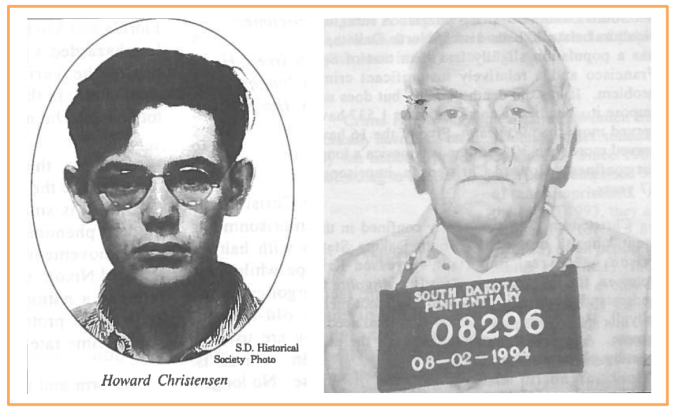
Howard Christensen before and after: at the time of his capture in 1937, and 57 years into his 64-year stretch. “I had life for murder, and they cut it to 200 years…”
Further details of the Christensen case can be found in E.L. Thompson’s book 75 Years of Sully County History, 1883-1958, which notes:
“The murder of Miss Ada Carey, of Blunt, on May 21, 1937, which was one of the worst crimes ever committed in South Dakota, brought a sudden end to a planned crime career of two Chicago youths, Howard Christensen, 16, and Norman Westberg, 17, whom Miss Carey had picked up as hitchhikers, but who later beat her up and shot her in an attempted hold-up on the highway several miles north of Onida. Miss Carey, who had been teaching school in the town of Frankfort for two years, had stopped in Gettysburg to visit a friend en route to her home in Blunt.
“The crime terminated with the wrecking of the car near the Myers farm about four miles north of Onida. According to officials, it was thought the shooting occurred in the vicinity of the hill south of Agar, coming down to Okobojo Creek. It was about here that Miss Carey was hit over the head with a hammer by Westberg, then shot by Christensen and fell out of the car as it came to a stop in the ditch. Putting her in the rear seat the boys then speeded on until they noticed a car following them, attempted to stop for a side-road and tipped over into the ditch. The boys abandoned the car and fled westward, while Frank Hiatt of Huron, who had been following them stopped at the scene of the accident briefly and then went on for help. He stopped at the William Ruckle farm where he requested Mrs. Ruckle to return and watch over Miss Carey, and then continued to Onida where he notified officials. Dr. V. W. Embree accompanied Sheriff Jack Reedy to the scene and brought Miss Carey to the hospital in Onida for immediate treatment. Although in a very weak condition, she was able to furnish a description of the boys and sign the statement taken by Attorney F. M. Ryan. She identified Westberg as the boy who shot her and Christensen as the one who hit her over the head with a hammer [sic – which of course leaves it quite moot as to which boy did what]. Miss Carey died at 2:50 that afternoon.
“Men from Onida, Agar, Gettysburg and surrounding territory searched the countryside and finally located the boys northwest of Onida on the Cottrill place hiding in a ditch among some weeds. They were brought to the courthouse for a brief questioning, then to the hospital where Miss Carey identified them, then back to the courthouse for further questioning. Sheriff Reedy then took them to Pierre when word of Miss Carey’s death was announced and threats were heard among the large crowd against the lives of the prisoners.
“The two boys pleaded “not guilty” to the crime. The jury’s verdict stated the boys ‘while engaged in the commission of a felony, killed and murdered Miss Carey.’ A life sentence is mandatory for murder in this state.
“At the time of the conviction a petition was signed by about 3,000 people in this area and filed with the Board of Pardons that these boys could never be pardoned.”
The case aroused such passions that it led directly to the reinstatement of capital punishment in the state, according to articles published in the 1990s.
Westberg hanged himself in 1943, but Christensen was still in prison in 1996, when his case was referenced by Paula Mergenhagen and Rachel Dickinson, in “The prison population bomb”, American Demographics Feb 1996. Mergenhagen and Dickinson noted: “South Dakota State Penitentiary officials wanted to put Christensen in a conventional nursing home, but they were afraid he wouldn’t be welcomed.”

Interior of the abandoned insane asylum at Yankton, SD, where Howard Christensen spent more than 30 years.
A very similar state of affairs was reported by the Burlington Hawk Eye of 21 August 1996, which described Christensen as “slightly demented” and said he had spent 58 years in jail and psychiatric hospitals – including more than 30, off and on, at the Yankton state mental facility. Unlike the inoffensive Richard Honeck, Christensen had “a long history of being obnoxious to his visitors and fellow inmates,” according to a prison spokesman at South Dakota State Penitentiary, where the murderer had received nine courses of electric shock treatment, and where was kept on the psychiatric ward. Officials were doubtful any nursing home would agree to take a tricky, notorious and unrepentent killer, who “harrassed visitors, refused to change his clothes, and was so unpleasant officials feared other inmates would attack him.”
Christensen’s personal hygiene, psychiatric unit manager Kris Petersen observed, “leaves something to be desired, but we work on that. We make sure he gets showered and shaved, that he’s eating properly, and receiving his medications.” For the most part, he was fortunate to spend so much time in a medical facility; his time in “general population” saw him suffer considerably from the attentions of other prisoners, and develop “a terrible habit of yelling and screaming all night long,” Petersen said, “which only intensifies this kind of negative behavioural cycle.” Consideration was given to subjecting Christensen to a frontal lobotomy to “render him more docile,” but that procedure was never carried out.
Thanks to the prisoners who staffed The Angolite – an award-winning journal written, edited and published by the inmates of the Louisiana State Penitentiary at Angola, LA – we possess an unusual window into the experiences of a man serving out an extraordinary prison sentence. Christensen was interviewed by phone about his time in gaol in 1994, nearly 60 years into his sentence, when he was already 74.
Angolite: Why do you think you’ve been locked up so long?
Christensen: Why? I don’t know why. I can’t figure it out myself. You know what one guy did in here? In 1938, he grabbed ahold of an 18-year-old girl, and cut her up real bad with a knife and raped and killed her. He’s freed. Two guys killed the warden in 1938, too. Smuggled in .22 caliber revolvers and murdered him. They only spent 25 years here and got out. I don’t know why they’re keeping me here so long.
Angolite: You didn’t have any problems?
Christensen: No. Some guys forced me to let ’em commit sodomy on me. They said they was gonna stab me to death if I didn’t do that. One guy had a spoon, he’d sharpened the handle on the floor, and he pointed it at my belly, said he was going to stab me if I didn’t let him come up to my cell and let him commit sodomy on me. They did that to all the boys that come into the prison then. Old-timers. Mostly old men and that…. They called the guys like that ‘queens’. They called us all queens then.
Angolite: When these people were sodomizing you, what did you do about it?
Christensen: Nothing. I didn’t do nothing about it… I was afraid if I told the authorities, someone would murder me. They don’t like stool pigeons in here you know.
Angolite: How did you get them to leave you alone, eventually?
Chistensen: I don’t know. I just stopped doing that. I didn’t say anything. I didn’t like it, though, to tell you the truth.
Angolite: Have you ever had a girlfriend?
Christensen: No. Yeah, I had a girlfriend up at Yankton. She died in Bridgewater Rest Home about four years ago. She wouldn’t let me make love to her, though. She said, ‘I don’t do that. I’m a decent woman.’ She’s the only girlfriend I ever had. My ma told me to stay away from girls, they cause trouble.
Christensen’s sentence of life without the possibility of parole was reviewed midway through the 1970s and cut to one of 200 years – a seeming technicality that in practice made him eligible for parole. He spent some time in two half-way houses, but was returned to prison after “acting peculiar” and displaying bad table manners, according to state records. “He’s very easy to talk with,” said Pat Haley, chairman of South Dakota’s Corrections Commission. “He’s like a child in a lot of ways… his development was arrested about the time he went to prison.” His case manager, Bonnie Larson, confirmed this in 1994. “As a trusty [he] went on furloughs. Somebody here in [Sioux Falls] would pick him up. He’d go downtown for ice cream, and want to come back home. His socialization skills are at what I would term a pre-teen level… He’s funny, and he can play a lot of good cards. But as far as adapting to life, taking on responsibility, earning his own way…”
Christensen was finally paroled by Governor Bill Janklow some time in June 2001 on the grounds of health and was dead by June 2003. [Sioux Falls Argus Leader, 29 June 2003] That would suggest he served a sentence of 63 or 64 years. In fact we can narrow it down further, because the date of sentencing is given by the Portsmouth Times [Ohio], 5 June 1937, as that day’s date. Hence it seems that the longest Christensen could have served was 64 years and some days, and he must have fallen just short of Richard Honeck’s record.
Longest spells in solitary confinement

Albert Woodfox (left) and Herman Wallace (right) with their 11 year old British visitor, Poppy Richards.
When Thomas Silverstein killed two fellow inmates and a prison guard at the federal gaol at Marion, Illinois, the authorities responded by issuing a “no human contact” extreme solitary confinement order, under which he spent 10,220 days (almost 28 years) as “America’s most isolated man,” the first part of it locked in a cell measuring 6×7 feet – so small he could touch both sides with his outstretched arms – for all but one hour a week. For his first 12 months of isolation, he was further punished by being refused all access to visitors, music, TV and reading materials, other than a Bible.
Wrote Silverstein (no choirboy – he was an armed robber and active member of the Aryan Brotherhood who had killed one other prisoner before he fetched up in Marion): “Due to the unchanging bright artificial lights and not having a wristwatch or clock, I couldn’t tell if it was day or night. Frequently, I would fall asleep and when I woke up I would not know if I had slept for five minutes or five hours, and would have no idea of what day or time of day it was.

Silverstein taught himself to draw during his lengthy stretch of solitary. This is his own sketch of his cell in America’s “supermax” AMX jail in Atlanta.
“I tried to measure the passing of days by counting food trays. Without being able to keep track of time, though, sometimes I thought the officers had left me and were never coming back. I thought they were gone for days, and I was going to starve. It’s likely they were only gone for a few hours, but I had no way to know.
“I was so disoriented in Atlanta that I felt like I was in an episode of the twilight zone. I now know that I was housed there for about four years, but I would have believed it was a decade if that is what I was told. It seemed eternal and endless and immeasurable.
“There was no air conditioning or heating in the cells. During the summer, the heat was unbearable. I would pour water on the ground and lay naked on the floor in an attempt to cool myself.”
Equally worthy of note is the case of two imprisoned Black Panthers, Herman Wallace and Albert Woodfox, who when their case was reported by the BBC in 2012 had spent 40 years in solitary confinement for the murder of a prison guard named Brent Miller in 1972. Both men – originally jailed for armed robbery – say that they joined the Panthers in an attempt to improve the appalling conditions in Louisiana State Penitentiary; aside from a brief spell in 2008 spent in a high security dormitory, they spent 23 hours a day locked up alone for the whole of that time. They continued to protest their innocence.

Herman Wallace’s sketch of his solitary confinement cell. The obsessive interest evident in its exact dimensions may be a product of 40 years spent within its four walls.
A federal court ordered that Herman Wallace be released from prison on 1 October 2013 after his 1974 murder conviction was finally reversed. He was suffering from liver cancer and died three days later.
Wallace told his lawyer George Kendall that solitary confinement – in a cell that, in his case, was six feet by nine feet (three metres by two) – “is the cruellest thing one man can do to another.” He had kept in shape using dumb-bells made of old newspapers which he had constructed himself. The evidence for the two Black Panthers’ involvement in Miller’s death, most sources report, was weak; there were no fingerprints at the scene, and Miller’s wife stated she had doubts about the conviction and hoped the pair would be fairly treated. The case was prosecuted twice, and in both cases, convictions were overturned on appeal.
As for Woodfox, he was not released until early 2016, by which time he had completed 43 years and 10 months of almost continuous solitary confinement – during which he suffered numerous panic attacks and significant claustrophobia. He was then still in reasonable health, and told The Guardian (20 February 2016) that he and his friend had “made a conscious decision that we would never become institutionalised… We made sure we always remained concerned about what was going on in society – that way we knew that we would never give up. I promised myself that I would not let them break me, not let them drive me insane.”
The two men’s motto, Wallace said, was “always far apart, but never not together.” Some slight insight into their experiences in solitary is offered by a post written by a young British girl, Poppy Richards, who visited the pair around 2008. She had been writing to them for a year at the urging of her mother, self-professed “renegade potter” Carrie Reichardt.
“I think that there is something significant about the innocence of a child,” Richards wrote. “Being only 11 at the time, when I stepped into the visiting room of Louisiana State Penitentiary and ran up to Herman Wallace to give him a hug I was completely unaware of how strange this must have been to everyone else in the room. It was only a long time afterward that I realised. A white, 11 year old girl running into the arms of a convicted murderer, a peculiar sight to the other inmates, their families and prison guards alike.
“I asked Herman and Albert questions about their daily life, what was the food like? How long did they spend in their cells each day? I tried to imagine being contained 23 hours a day, constricted to a limited few occasional activities, and being served just about edible food onto the cell floor. Of course it was impossible, it was completely unimaginable to me, just as it is to most people.”

Albert Woodfox was released after legal manoeuvres that saw his murder conviction quashed and a plea of no contest entered to lesser charges of manslaughter and burglary.
General studies of the effects of solitary confinement make grim reading. Anything longer than around three months of such treatment, notes Terry Kupers, a professor of psychiatry at Berkeley, tends to result in heightened states of anxiety, including panic attacks, paranoia and disordered thinking. Compulsive actions increase, basic cognitive functions are dulled. Former Harvard Medical School faculty member Stuart Grassian adds that the worst aspect of such regimes is the lack of stimulation. Without it, he observes, “people’s brains will move toward stupor and delirium – and often people won’t recover from it.”
Listing of record U.S. sentences served, by state
With only a couple of exceptions, every American state has incarcerated felons for periods in excess of 40 years. Many of these cases are those of prisoners who had death sentences commuted. As one would expect, many also involve crimes committed against women and children, but there is also a second category, noticeably common, involving crimes committed (or said to have been committed) by blacks against whites.
Since life expectancies have improved substantially over the course of the last century, and prison conditions are on the whole better than they once were, too; and since there are presently around 160,000 prisoners serving life sentences in the US; and since almost one in three of those lifers are serving sentences that exclude the possibility of parole, it seems inevitable that all these records will eventually be beaten. Indeed, if Frank Smith of Connecticut – who began his sentence of life without parole for murder on 7 June 1950 – survives, Paul Geidel’s unwelcome milestone could be passed as early as 8 February 2019, and Charles Fossard’s on 7 March 2021.
Here, then, is a series of mini-studies of the longest sentences served in various places:
-

Today’s St Clair Correctional Facility, home to Roosevelt Youngblood in 2002, offers comforts that are a vast improvement on those typical in the Alabama prison system in the 60s…
Alabama. According to a newspaper article published in 2002, Alabama’s longest serving prisoner at that time was Roosevelt Youngblood, 61, who had been sent to prison – for life – for robbery in 1961, who had killed a total of three fellow inmates in the course of the 1960s and 1970s, and who was not due for parole until 2008. As Youngblood told it, responsibility for the murders he committed rested as much with the appalling Alabama prison regime as with him – he had killed simply to survive in a brutal, filthy and overcrowded penitentiary, run by a system so bad that it had to be taken over by the federal courts simply in order to ensure that inmates had access to things such as toothbrushes and flushing toilets. Being in prison in Alabama, he asserted was like “being out in the jungle with a bunch of cobra snakes.” Youngblood was not alone in this assessment: Alabama lawyer Alvin J. Bronstein describes Fountain, the facility he was held in as a place “shocking to to conscience,” where an average of 50 sexual assaults occurred each week, where “people were being raped, beaten, there was stealing and the guards were afraid to go in there and didn’t go in there.” If Youngblood was at Fountain in the 60s, Bronstein adds, “he would almost have [had] to [kill] to stay alive.” The Youngblood of 2002, however, was old for 61 – partially paralysed by a stroke, afflicted by cirrhosis of the liver (which sounds like a further indictment of the Alabama prison system) and suffering constant pain from a bullet lodged in his spine – an injury inflicted when he was shot by a guard for fighting with another inmate “who drew an ice pick on him.” He insisted on calling the other prisoners with whom he shared his time “associates”, not “friends” – which is perhaps not surprising when one considers that St Clair, the correctional facility where he was by then imprisoned, has been described by vice.com as one of the most dangerous lock-ups in the US, with five prisoner-on-prisoner killings in only 30 months, and “a toxic mix” of problems, which apparently included “overcrowding, a warden who doesn’t care what prisoners do to one another, and drug-dealing guards who sometimes order hits on inmates.” Youngblood slipped out of sight after featuring in that one report – published in the Tuscaloosa News, 12 May 2002 – but some legal documents supplied by a commenter [below] show that he died, apparently of cirrhosis of the liver, sometime in the first quarter of 2004. That means he must have served a total of around 44 years.
- Arizona. Betty Smithey [above] was the longest-serving female prisoner in the US at the time of her 2012 parole. She had completed 49 years of a sentence for the murder of a 15-month-old girl whom she had been babysitting.

Inmates at the Arizona State Prison Complex, in the desert at Florence – home to Jimmie Williams for almost 50 years.
- Arizona. “Crazy Jimmie” Williams probably wasn’t mad when he entered the Arizona State Prison complex at Florence in 1948, aged 17, after murdering his aunt. But the 49 years he spent inside its walls cannot have helped. Some days, recalled Michael Berger of the State Department of Corrections, he seemed quite lucid, but on others “he had long, drawn-out conversations with the clothes he was going to put on after a shower.” Like several of the prisoners I’ve investigated, Williams stayed in prison longer than he might otherwise have done because he had no close family and preferred not to apply for parole. He died, aged 66, of the effects of a stroke, still in jail. (Tuscon Citizen, 17 June 1999).
- Arizona’s Louis Taylor served the longest sentence – 42 years – that I have record of for prisoners who had their sentence vacated or overturned. He had been found guilty of setting a fire in a Tuscon hotel that killed 29 people. Evidence suggested that, while he was at the scene, he had actually been helping guests to escape the flames. Although not formally cleared, he had always pleaded his innocence and was eventually released as part of a deal that saw him plead ‘no contest’ to avoid the delay and cost of a retrial.
- California. Booker T. Hillery, who remains in prison coming up for 55 years after his conviction for murder, is serving time for the killing of a 15 year old girl, Marlene Miller, in 1962 and is California’s longest-serving male prisoner. Details of the case are contested. Hillery (who is black, while Miller was white) was convicted by an all-white jury and made extensive efforts between 1962 and 1985 to seek a retrial. Those who oppose his release point out that he was on parole for an earlier rape conviction at the time of the murder, and that at least one fellow inmate claims to have heard him confess to stabbing Miller.
-

Patricia Krenwinkel, centre, seen at the time of her trial. She is flanked by fellow Manson family members Susan Atkins (died in jail 2009) and Leslie Van Houten.
Meanwhile, Betty Smithey’s release [above] leaves Manson Family members Patricia Krenwinkel and Leslie Van Houten as almost certainly the longest-serving women in the US prison system. The pair were convicted on 25 January 1971 and – after commutation of their death sentences to life terms – had, as of April 2017, both served 47 years in the California penal system for their parts in the Family’s murders. (Van Houten spent six months out of prison, on bail awaiting a retrial, in 1978. Denied parole, for a 21st time, after her most recent hearing in June 2016 when Governor Jerry Brown personally intervened to overturn a recommendation that she be released, she remains in prison pending a further hearing scheduled for September 2017. She is now 67 years old.)

The case of “Old Fitz” Fitzgerald, paroled from Folsom in 1971, shows that long prison sentences were served out before the modern prison era. Richard Honeck’s near-contemporary put in a total of 59 years in jail for three separate offences, including the murders of a Montana sheriff and a San Gabriel policeman.
- Also worthy of mention is one old-timer, Charles “Old Fitz” Fitzgerald, a long-serving career criminal who was finally paroled from California’s Folsom Prison in 1971, at the age of 85. Fitzgerald was then the longest-serving inmate in the state, having first gone to the pen in 1908, aged 22. He served three years for burglary, and, after his release, killed a Montana deputy. That crime earned him a 100-year sentence, but he was paroled as a reformed character after only 11 of those years – only to kill again in 1926 while participating in a rum-running operation during Prohibition. “Old Fitz” served 45 years for that final crime, and survived his second parole by five years, dying aged 90 on 30 October 1976.
-

Murderous janitor Joseph Morse at the Boulder [CO] courthouse.
Colorado. Colorado University janitor Joseph Dyre Morse, the state’s longest-serving prisoner, was convicted in December 1966 of the rape and murder of CU coed Elaura Jacquette. She had been horribly assaulted in the organ practice room at the university’s Macky Auditorium – producing what Boulder police chief Dave Voorhis described as the most horrific crime scene he had ever investigated. Morse, who was turned in by members of his own family after arriving home with blood-soaked clothes, received an 888-year term and denied his guilt for years before eventually confessing in 1980. He died, still in prison, in 2005, 38 years into his sentence.
- Connecticut. Burglar Frank Smith remains in gaol 67 years on for the July 1949 murder of a nightwatchman during a break-in at a yacht club in Greenwich; see above.
-
Florida. It seems that Gary Alvord – awarded the unwelcome soubriquet of “the man too crazy to be executed” by the Tampa Bay Times – holds the record for longest time spent on death row in the United States. He served 39 years for the 1973 killing of three women, seeing out eight presidents, nine Florida governors and two different death warrants before falling victim to a brain tumour in May 2013. Alvord, a schizophrenic from Michigan, was a prolific thief, molester and kidnapper on the run from a prison sentence for rape when he strangled Ann Herrmann – and then killed Herrmann’s mother and daughter – for the crime of overcharging a friend for a game of pool.
- Florida’s longest-serving prisoner of all, though, was Hugh Alderman – an old-time bank robber whose 62-year stretch in jail began when he was 23 years old, way back in 1917. Alderman was the sole survivor of a four-man gang led by the Rice brothers, Leland and Frank – two experienced career criminals – which held up the Homestead Bank in south Florida on the afternoon of 15 September 1916 and got away with $6,000. They were armed with “automatic shotguns,” and – pursued into the surrounding Everglades swamplands by a posse led by Sheriff Allen Henderson – the gang opened fire, killing three of their pursuers.

The bank at Homestead in the 1920s, a few years after it was robbed.
The resultant manhunt was “without parallel in the history of south Florida,” a newspaper noted at the time, and at least 150 citizens ignored the dangers of being shot – not to mention the discomforts of the heat, humidity, and ever-present swarms of mosquitos – in order to join the hunt. Local residents, meanwhile, hurried to arm themselves and “slept on their guns” for the nearly two weeks that the gang remained at large. Posse members finally caught up with the Rice brothers, separately, on 27 and 28 September. Remembering the fate of their colleagues, the lawmen took no chances, and both robbers were gunned down; Leland Rice was killed and his brother paralysed by a posse bullet. The third gang member, Jim Tucker, drowned swimming a river in his attempt to escape, and Alderman was eventually detected hiding in an empty house, where he surrendered. Narrowly escaping a lynching, Alderman and Frank Rice were taken to Miami, where they went on trial, separately, in 1917. Rice got life, but was paroled nine years later, in October 1926. It seems likely this was because of his deteriorating condition; he died two weeks after his release. But Alderman, who received a life sentence of his own on 8 November 1917, lived on. His time in prison was punctuated by two short-lived escapes – in 1919 and 1924 – but in April 1927 he was transferred to the Florida State Hospital for the insane, where he remained confined until his death on 4 May 1980.
-

Alfred Tai: shot down a policeman in the wake of an armed robbery.
Hawaii. Armed robber Alfred Tai and his partner Kenneth K. Lono organised the hold-up of the Paradise Cocktail Bar in Kapalama, Oahu, in December 1963, using pistols and carbines they had stolen from the National Guard Armory in Kaneohe two months earlier. Stopped by the police a week after the successful heist, Tai and two confederates – Lono and John Kekai-Requilman Jr. – opted to shoot their way out, killing officers Abraham Mahiko and Andrew Morales. Kekai-Requilman was paroled in 1975 and Lono died, aged 73 and still incarcerated, in 2003, but Tai – a former juvenile offender who had been in trouble with the authorities ever since the age of 10 – served on, to be eventually paroled, aged 72, on 30 June 2014. He had served 51 years of his life sentence.
- Idaho. Sentenced to a short stretch in jail for robbery back in 1969, 21-year-old Ronald Lee Macik was found guilty of killing a fellow inmate during a prison riot two years later. He has violated four paroles, and has a troubled personal history the first saw him enter an institution aged only two. Macik admits lacking all the social skills necessary to survive in the outside world, and as of April 2017, he had completed almost 48 years for the two crimes. He continues to protest his innocence of the prison killing, and has “the lowest inmate number in Idaho, meaning no prisoners who were at the prison when he arrived remain.”
-
Illinois. William Heirens, of Chicago, was a 17-year-old “organised lust killer” when he went to jail for three murders on 5 September 1946; he died on 5 March 2012, still behind bars, still insisting he was innocent, and as the then longest serving prisoner in the world. Heirens earned the soubriquet “The Lipstick Killer” after scrawling the words “For heavens/sake catch me/before I kill more/I cannot control myself” onto the wall of his second victim’s apartment; his original story was that the crimes had been committed by his evil alternate personality, “George Murman.” He was highly intelligent and, having begun college in his home town at the age of 16, was consistently referred to in the press as the “University of Chicago brightboy.” Heirens fought a long battle for freedom, but by early 2011 – the Chicago Reader reported – things were going rapidly downhill for the country’s longest-serving inmate. He “can’t get out of bed or bathe himself,” a reporter wrote, “and his cataract-plagued eyes have left him unable to read. He has severe diabetes and gets shots of insulin twice a day, along with a cocktail of other medications. Nurses constantly change bandages on his legs, where diabetic sores weep fluids. They say he is beginning to show signs of dementia.”
- With Heirens dead, Illinois’s longest-serving prisoner is presently Chester Weger, the Starved Rock Murderer, who confessed in 1961 to the bludgeoning of Lillian Oetting and two other women the previous year.
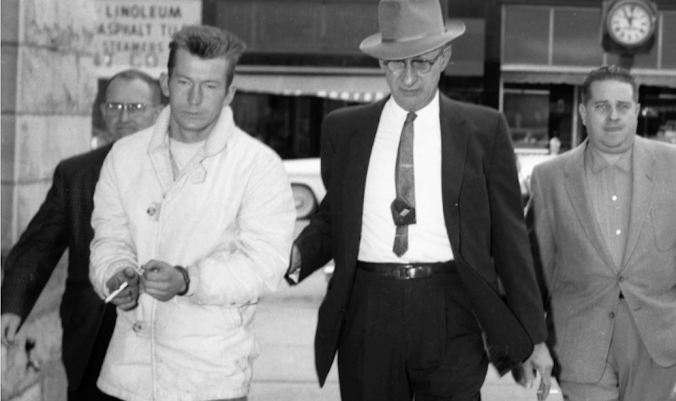
Chester Weger remains in jail for the murder of three women at Starved Rock, Illinois, in 1960. Their hands had been bound with twine, and a bloodstained branch was found nearby. Weger protests his innocence, but items from the murder scene that he says could prove his case were contaminated; DNA testing is now impossible.
- Entirely unsurprisingly, Indiana‘s record holder is still Van Dyke Grigsby; see above.
-

Warren Nutter reads a letter from his mother in his cell.
Iowa. Warren Nutter has spent a lifetime in prison for one moment of vicious stupidity. Convicted of the murder of a policeman in a botched robbery at the age of just 18, Nutter was the youngest person ever sentenced to death in his state, but had his sentence commuted to life imprisonment a year after his February 1956 conviction. The facts of the case were bathetic. Already on the run from a young offenders’ home, and heading for California on an impromptu road trip with five friends, one of them his girlfriend, Nutter decided to raise a little pocket money by holding up a petrol station. An alert patrolman pulled him and his companions over as they made their escape and took them in for questioning. Nutter escaped from the police station through an open toilet window, grabbed a shotgun from his car, and used it to cut down officer Harold Pearce. He was picked up four hours later while attempting to hitch a lift on a nearby highway. According to the statement that he gave to the police: “I remember I didn’t want to leave the others, especially Bette, back there in the police station. I had a shotgun in the car, and then it was in my hands and I was going back into the station. I pointed the gun at the officer…. And the next thing there he was stretched out on the floor and the room was roaring with a gunshot and I was running. I ran and ran. It was like a bad dream – your legs won’t move fast enough and you can’t get away from the thing chasing you. It didn’t take them long to catch me…”
Asked why he had done it, Nutter added: “I wasn’t mad at him… I just… I don’t know why.” Six decades later, that’s still a question with no answer.
-
Kansas. Joe Carr’s crime was murdering a baby. The boy was only six weeks old when Carr threw him into the Arkansas River on 12 September 1941 after telling his wife he was going to find a home for the infant somewhere in Wichita “because we didn’t have any way to take care of it.” Instead, he strangled the baby as he walked towards the river and then dropped the body in. Carr pleaded guilty to murder one week later and repeatedly refused to apply for parole. Jailed on 2 October 1941, he last made the news in 1995, aged 77, but the records of the state’s Department of Corrections reveal that he survived to have parole thrust upon him. He left prison on 13 August 1997, seven weeks short of spending 56 years inside.
- Kentucky. Willie Gaines Smith was Kentucky’s longest-serving prisoner, having swapped an appointment with the electric chair for a life sentence for the murder of a store clerk during a robbery. Smith entered prison on 31 August 1960; his co-defendent was paroled in 1981, but he himself remained in prison as of 2014 despite being granted medical parole because he needed nursing care; no care home would agree to take him in. He died, aged 76, on 14 December 2014, midway though his fifty-fourth year of imprisonment.

Willie Gaines Smith – jailed for murder on 31 August 1960, and denied access to parole hearings in 2004. “I’ve been here long enough,” he told a reporter in 2014. “I’ve served it out.”
- Louisiana. It’s hard to get accurate information out of the Louisiana prison system, but its longest-serving inmate looks likely to be Leotha Brown, who is now in his 70s and went to prison there early in 1964 for robbing and shooting a bartender in a swing club. I’ve found no record of any parole, and Brown was certainly still in the state’s notorious Angola gaol as of 2011, when he featured, playing soprano saxophone, in a documentary on prison music. He appears to have become a model prisoner, running leadership courses, studying for college credits, and assisting at the Angola Bible College. If he is indeed still in jail, Brown is [April 2017] currently approaching the end of his 53rd year inside.
-
Maine. French-Canadian Albert Paul, a thief, killer and prolific escapee, is the oldest and the longest-serving prisoner in Maine. He first went to prison aged 18 in the early 1950s, but says he has “lost the fire” for trying to break out and accepts that he will die in jail. The state estimates that it has paid $1.5m to keep him incarcerated over the past 64 years, and his current sentence, for a murder he now says he did not commit, began in 1971, meaning that – as of April 2017 – Paul was 83, and 45 years into his latest stretch. The secret to serving time, he says, is to distance oneself from the outside world as much as possible. “There’s two worlds: free world and prison world, you know?” he told a reporter who became his first visitor in 13 years. “I don’t want people visiting me saying, ‘Oh, we was down at the beach over the weekend.’ I don’t want to hear that kind of talk. I can’t go to the beach. You see?” (Portland Press-Herald, 13 April 2013)
- Maryland. Charles Edret Ford launched a highly unusual appeal against his murder conviction in July 2015 – unusual in that the prosecutor and all the witnesses who featured in his 1952 trial were long dead, there was no trial transcript, and almost all of the records relating to it had been destroyed around 2009. Ford, who is black, had been convicted by an all-white jury of the shotgun murder of one Vincent Lewis (who had, in turn, apparently killed Ford’s brother). He claimed to know the identity of the real murderer, but declined to reveal it, adding that both he and his girlfriend were coerced into making confessions by an officer who hit him in the face with his night stick. Ford did have an alibi – he said he and his girlfriend were with another brother at a dance – and there were also discrepancies in witnesses’ descriptions of the killer, one stating that he wore a light coat and dark trousers, another that the colours were the other way around. By the time the appeal was lodged, Ford was suffering from cancer and showing early signs of dementia; as a result, he was released from prison into the care of the Blue Point Nursing Rehabilitation Centre in December 2015, and a few months later, his attorneys managed to have the murder conviction discharged on the grounds that the judge had failed to apprise the prisoner of his post-trial rights. That still left the problem of a second conviction, for assault, which had been incurred in the course of a furlough Ford had been granted in 1975; the judge dealt with that by changing the sentence on the second offence to one of five years, all suspended. Ford, who was aged 84 at the time of his release, wept tears of joy on hearing he would be freed, and told a reporter his main aim now was “to live as long as I can, as happy as I can.” One sidelight is that the modest publicity surrounding the appeal led Ford’s great-niece to surface and establish contact with him – shades of the Richard Honeck case.
-
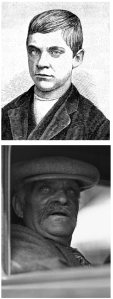
Jesse Pomeroy, before and after: aged 15 in 1874, at the time of his conviction, and aged 69 in 1929, 54 years into his stretch. The latter photograph was snatched as the child-killer was being transferred to Massachusetts’s state mental hospital.
Massachusetts. They called him ‘The Boston Boy Fiend,’ and he really was a child. Jesse Pomeroy, who went to prison for two murders back in 1874, then aged 15, still holds his state’s record for the longest sentence served, having survived into his early 70s and completed very nearly 58 years in the pen. Pomeroy had begun his criminal career years earlier, when he was only 12. The child of an abusive father, and possessed of a strangely unforgettable face – one eye was milk-white and regularly described in the contemporary press as ‘like a marble’ – the young Pomeroy enjoyed torturing animals and soon graduated to beating up much younger boys. His earliest victim, William Paine, was only four years old when he was waylaid, brutally assaulted, and left suspended from a beam in an abandoned cottage. Nearly a dozen other similar attacks followed, but in September 1872 Pomeroy’s luck ran out when he walked into a police station house at the same time as one of his victims, and was promptly identified and sentenced to juvenile detention. Pomeroy’s record was so good that he was released only a year and a half later, but it took only a matter of weeks for him to return to his old ways. His first murder was committed in March 1874 when a 10 year old girl, named Katie Curran walked into the Pomeroy family’s store hoping to buy a notebook. The boy – by then 14 – took her down to the cellar, where he cut her throat with his penknife and hid her body beneath a pile of rubbish. A second equally violent and senseless killing followed the next month; this time the victim was a boy of four. Discovered shortly afterwards, when the cellar in which Curran had been interred was dug up to be redeveloped, Pomeroy was sentenced to death that same December, only to have his sentence commuted to life because of his age. Instead, he served out an astonishing 41 years in solitary confinement before being switched to general population in 1917. Just over a decade later, he transferred to the Bridgewater Hospital for the Criminally Insane, where he died, aged 72 and still incarcerated, on 29 September 1932. Pomeroy was, it seems, highly intelligent – he wrote an autobiography and taught himself several languages while in jail – and (so the Boston Globe reported) he made at least a dozen unsuccessful escape attempts during his years in solitary. His story has been told twice in book form, by Harold Schechter and Roseanne Montillo.
-
Michigan. Armed robber Clarence Marshall was paroled on 27 January 2015, 64 years and two months into his jail sentence – edging out by about one month the time served by Richard Honeck, and making him one of the top ten longest-serving prisoners that I know of. He is also by far the most obscure. For reasons that escape me, Marshall’s case remains almost entirely unreported; despite searching, I have found no press coverage of either his conviction or of his release. What we do know is that he received a sentence of life for two counts, one of armed robbery in September 1952 and another of an unarmed “assault with intent to rob and steal” in November 1950. He was born on 18 May 1930, making him 84 years old at the time of his parole.

Oliver Terpening before and after (1947 and 2010): murder disappointed him, but he had 63 years to reflect on why.
- Marshall’s stretch beat out the time served by another old Michigan lag, Oliver Terpening, who murdered a schoolfriend and the boy’s three sisters in May 1947 for no better reason than that he wanted to find out what it felt like to kill another human being. Terpening – a farmboy who was then just 16 years old – and his neighbour Stanley Smith, 14, were on a can-shooting and wildflower hunting expedition near Imlay City when Terpening shot Smith through the back of the head with a hunting rifle. “I’ve always kinda wondered what it would be like to kill somebody,” he later said. “I just wanted to see someone die.” According to the prosecutor who tried him, Terpening then attempted to rape Barbara Smith, also 16, but was interrupted by her sisters Gladys, 12, and Janet, 2. “I thought the best thing to do was to kill them all,” he concluded; after murdering the three girls, he pressed flowers into their hands, went home for dinner, and then tried to make a break for it in the family car. He got as far as Detroit before being picked up by the police. The judgement of a panel of psychiatrists, who argued that Terpening was mentally unbalanced, was overturned, and he was found to be sane and sent to prison. He spent more than 63 years behind bars, dying, still incarcerated, on 29 October 2010. At the time of the killing, Terpening expressed disappointment that he “didn’t get the thrill I expected.” (Mexia Weekly Herald, 27 June 1947) By 1982, he had apparently repented, telling a newspaperman who came to see him in the Jackson pen: “It’s something I never get away from – the memory of it. It’s probably the hardest thing in the world to live with.” But he had decided against suicide: “Actually, although I’m in prison, I’m a free man. I’m my own person, despite the guns and the walls and the guards… I have a cell where I can watch the sunset. It has its rewards – even in here.” (Ludington Daily News, 4 May 1982)
- That leaves Sheldry Topp. After more than 50 years behind bars, he has only hazy memories of the day he stabbed an attorney named Charles Davies in the chest and neck while burglarising the man’s home back in 1962. Topp was 17 years old, and on the run from the state mental hospital at Pontiac, at the time. While he fled the house before his victim died, he had fatally exacerbated the situation by dismantling Davies’s phone at the start of the break-in, preventing the dying man from calling for help. Topp now claims to be remorseful – though he adds, “I never understood how people go about showing remorse. I could break down and cry and so forth. People say that’s crocodile tears. I could yell and scream, and people would say that’s putting on a show” – and eight of the 10 parole board members who heard his case in 2011 recommended him for release. His request was denied by Michigan’s governor, Jennifer Granholm.
-
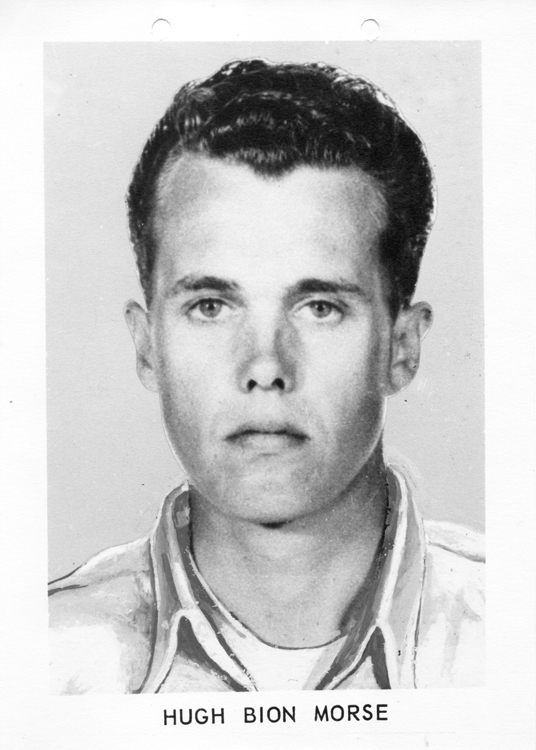
Morse: served 42 years for serial murder.
Minnesota. The only serial killer on this listing is Kansas City-born Hugh Bion Morse, a deeply unpleasant “rape-slayer” who killed at least four women. Morse was picked up in Minnesota on a fugitive warrant in the summer of 1961 after attempting the murder of his wife in California and raping and killing Carol Ronan in her own home in St Paul. He confessed to strangling two other women in Spokane, Washington, but it emerged only 20 years later that he had also bludgeoned a fourth victim to death with a lead pipe in Birmingham, Alabama, that same August. Morse, who was dishonourably discharged from the Marines, had a rap sheet dating back to 1951 that included assaults against women, indecent exposure, and child molestation involving girls as young as 6; in addition to being lead suspect in other, unsolved, murders, he was also responsible for several rapes in Georgia, a long series of burglaries in California, and, said the Chicago Sunday Tribune (15 Oct 1961), of “making obscene proposals to women over the telephone at Burbank, Cal.” At one point during the manhunt for him, he was picked up on suspicion of voyeurism and released on $200 bail, unrecognised by cops who failed to notice his resemblance to the man on the Wanted poster pinned to the wall behind them. Morse eventually served a little under 42 years of a life sentence, beginning in October 1961; he died in jail in April 2003. His was a miserable existence; he told police: “I can’t remember being happy any time since I was born.”
- Mississippi. Ernest (or Earnest) Lee Wilson had already been inside for six years, serving life, when he stabbed another prisoner, trusty Luther Wadley, to death while Wadley was sitting in a prison barber’s chair. That was on 3 September 1970; three years later, Wilson made a short-lived escape, but he was recaptured and remained incarcerated long enough to be listed as his state’s longest-serving prisoner late in 1994. By then he had completed 30 years inside, and was still only aged 51 or 52. I have found no further record of him and he is no longer incarcerated, but – given his youth and the double murder sentences he had received, I assume that he most likely both survived and remained in prison long enough to beat the time served by his state’s current record-holder…

Captured – Richard Gerald Jordan is paraded in handfuffs at the height of the fashion-conscious 1970s.
- … Richard Gerald Jordan, who in January 1976 murdered a woman he had kidnapped after demanding a $50,000 ransom for her, and remains incarcerated at Mississippi’s infamous Parchman Farm facility after 39 years – most recently after a judge halted a further attempt to execute him in order to investigate whether death by lethal injection constituted cruel and unusual punishment. As of April 2017, Jordan was coming up to 71 and remains the longest-serving inmate on the state’s death row.
- Missouri. Earl George was a middle-aged farmer in Grovespring, Missouri, back in 1947 when – he said – his wife “started at him with a butcher knife” while he was drying dishes. He retaliated by picking up a double-headed axe that he had lying about the kitchen and splitting open her head with it. George already had a record – he had been adjudged insane two years earlier after some hazily-described sexual encounter with a neighbour’s mare, and had spent time in six insane asylums in Missouri and Nevada. He remained incarcerated as late as the autumn of 1994, 47 years later, the last time I have record of his case. He would have been 94 years old by then.
- Nebraska. Few of the killers on this list proved to be more desperate or dangerous than Jerry Lee Hansen, Nebraska’s longest serving inmate, who went to jail on 20 May 1965 for the triple shooting of his wife and her parents in Cedar Bluffs. Both in-laws were killed and his wife was maimed in the attack, which took place within a few hours of Hansen bring served with divorce papers. Allowed out of jail to attend an Alcoholics Anonymous meeting in 1973, Hansen persuaded his guard to let him call on his by then former wife. He then attacked the prison officer and tied him up before using the man’s gun to shoot his wife for a second time. This time Sandra Soderling was paralysed, and her ex-husband picked up a second 20 year sentence for wounding her, to add to the one he had been handed in 1965. As of April 2017, Hansen had been in jail for almost 52 years.
-
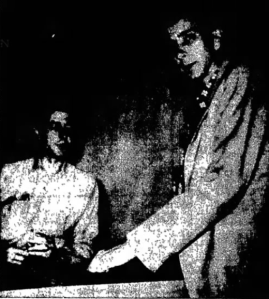
Raymond Shuman is booked for double murder just before Christmas 1957. Shuman is still held in a Nevada jail almost six decades later.
Nevada. Raymond L. Shuman, 23, was convicted of double murder on 13 June 1958 for his involvement in the robbery and killing of a truck driver and an electrician in the course of a “tri-state crime spree” that took place the previous December while he and an accomplice were both AWOL from the US Navy. Shuman and his fellow sailor Melvin Rowland (who actually pulled the trigger), got a pathetic $3 from the body of their second victim. He remains in prison with [April 2017] almost 59 years served, and has been no model prisoner. In 1973, he doused another inmate with lighter fluid and set him on fire in the course of a fight over whether the window near his cell should be open or closed.
-
Nevada’s second longest serving inmate was Jack Rainsberger, jailed in March 1959 for the murder of a Las Vegas secretary, Erline Folker. He served 41 years and made 20 applications for parole before being released, aged 65 and by that time in a wheelchair, in September 2000. During his years in prison – the first 13 of them spent on Death Row, awaiting an appointment with the gas chamber – Rainsberger became a published poet. “You have two choices,” he told one newspaper in 1973. “You could look to be executed and live for that. Or you could go about your business as though the execution did not exist… I live as if I was going to continue to live. I adopted the Vandanta School of Hinduism. I studied.” None of this cut much mustard with Folker’s son, who campaigned for many years for his mother’s killer to remain behind bars for life.
-
New Hampshire. Axe murderer Walter H. Bourque Jr. was convicted in December 1955 of killing a four year old girl, Patricia Johnson, and sentenced to a term of 18 years to life. Bourque was 17 at the time, and was reported in 2004 to be institutionalised, having apparently never been enrolled on the sex offender programme he had been told in 1999 to complete before he could be considered for release. Bourque flirted with freedom on several occasions – in 1977 he was on some form of day-release from a minimum security unit when he was accused of “inappropriate conduct with minors” and returned to jail, and in 1978 or 1979 he was out again on a short-term pass, but caught stealing a cheque. I have been able to find no firm news of Bourque since his case was in the press in July 2004, at which point he had completed more than 49 years in jail, but the New Hampshire Department of Corrections Inmate Locator lists him as still incarcerated and due for release on or before 11 June 2054. He completed his sixtieth year in jail on 10 December 2015.
- New Jersey. Howard Unruh died, aged 88, on 21 October 2009, 60 years and a little shy of two months after committing a major early mass shooting in the streets of Camden, New Jersey. He had planned the event for more than a year, and knew several of the five men, five women and three children whom he killed – being convinced, one obituary says, “that his neighbors were ridiculing him behind his back and plotting against him. He was also depressed about his homosexual liaisons in a Philadelphia movie theater.” Wartime tank gunner Unruh’s main target was actually his insurance salesman, but his spree was ultimately sparked by a distressingly prosaic incident – someone stole his front gate, sending him out into the streets armed with a Luger pistol (a souvenir of his war service) and 33 rounds of ammunition. His victims included a six-year-old boy, who was killed while sitting in a barbershop chair, and a young bride who had been married for only six weeks. Unruh – described as an introvert and “religious nut” – returned to his apartment after the shooting and barricaded himself in. He was captured by police who threw a tear gas canister through a window. Assessed as insane, he was incarcerated in New Jersey’s Trenton Psychiatric Hospital.
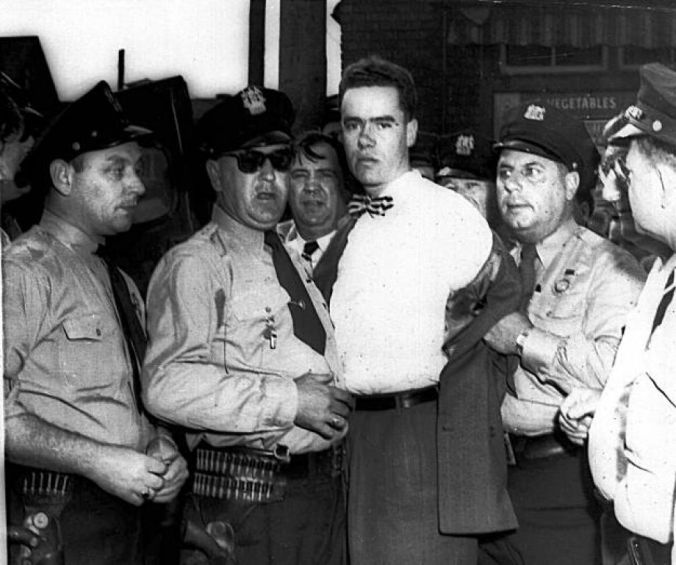
Howard Unruh, a spree killer who shot 13 people on the streets of Camden, New Jersey, in 1949, insisted: “I’m no psycho. I have a good mind.”
- If one excludes Unruh – who was never tried or sent to jail – New Jersey’s longest-serving inmate seems to have been Thomas Trantino, convicted of the cold-blooded killing of two police officers – one of them unarmed – in what is described as “a dank and seamy roadhouse bar on Route 46’s Sin Strip.” The “Angel Lounge murders” were committed in August 1963, and Trantino was paroled on 11 February 2002 after serving 38 years. His case remains highly controversial. Trantino wrote poetry and painted while in jail, attracting patronage from the likes of radical writer Howard Zinn, but leading NJ Lawman magazine to publish an article demanding an end to the humanization of a “brutal double murderer.”
-
New York. With Paul Geidel now long dead, the Empire State’s longest-serving prisoner is James R. Moore, who remains in prison in Rochester for the 1962 rape and murder of a 14 year old girl, Pamela Moss. According to contemporary newspapers, Moore also admitted the rape of a nine-year-old and 40 or 50 other instances of sexual assault. As of April 2017, he was about to begin his fifty-fifth year inside – putting him in much the same league, in time-served terms, as Winston Moseley, who killed Kitty Genovese outside her apartment building over a period of about half an hour in 1964. Moseley’s crime was noteworthy mostly for the fact that Genovese’s death was witnessed by 38 people, none of whom called the police; their apparent callousness features among the motives offered by Alan Moore’s comic book character Walter Kovacs (“Rorschach”) for donning a mask in the noted graphic novel Watchmen; he died in prison in March 2016, aged 81, after 52 years behind bars. And as of April 2017, Ricky Robles, jailed early in January 1966 for New York’s equally infamous “Career Girls Murders,” had notched in excess of 51 years in New York jails.

The violent murders of Janice Wylie (21) and Emily Hoffert (23) scandalised New York in the summer of 1963. The girls – both from upper class families, and ensconced in apparent security in a “fashionable” Upper East Side apartment – were bludgeoned and viciously knifed by a “baby faced” heroin addict in the course of a burglary gone badly wrong. Reconstruction by A Crime to Remember on the Investigation Discovery Network.
- North Carolina. John Phillips holds the record for this state, having been sentenced on 17 July 1952 and being now in his 64th year of incarceration for the rape of a five-year-old girl. But a second NC prisoner, cop killer Frank E. Wetzel [below] served 55 years for shooting two Highway Patrolmen, J.T. Brown and Wister Lee Reece, on 5 November 1957. The victims were shot in separate incidents, in two different counties, after pulling Wetzel over for speeding. Their killer was a career criminal with an IQ of 133. He had escaped from a New York mental hospital and was headed to Mississippi, apparently with the intention of breaking his brother out of death row. In 1982, a quarter of a century into a term of life without the possibility of parole, Wetzel married one Bianca Brown, who later claimed to have spent $100,000 on efforts to have him pardoned and freed on the grounds of mistaken identity. There do seem to have been oddities in the case; one witness said that Reese’s killer was “dark complexioned,” and possibly “Hispanic, Italian, American Indian, or black,” while Wetzel’s lawyer argued that it was “patently impossible” that one man could have have committed both murders in the 15 or 20 minutes that separated the two incidents; “he would have had to have averaged speeds of between 140mph and 190mph” on back country roads to have managed the feat, it was said. Once described by a North Carolina corrections officer as “the most potentially dangerous convict in the entire state prison system,” Wetzel died, aged 90, of Alzheimer’s Disease. His brother William, a “new York mobster” convicted of a prison murder, went to the gas chamber in Mississippi two months after the Reese-Brown killings.
-

Part of a “wolf-pack” armed with switch-blades… Media characterisation of Joe Ligon and his friends would impact on his sentencing, sending him to jail for life at age 15. Franklin [PA] Herald, 25 February 1953.
Ohio. Among the longer terms served by prisoners who were eventually cleared of the crime for which they had been jailed was the 39 years that Ricky Jackson spent in the Ohio pen for a murder he did not commit. Jackson was sent to jail with two friends in 1975 after being found guilty of the killing of money order salesman Harold Franks in Cleveland. The main witness for the prosecution was a 13-year-old boy who was sitting on a school bus a block away from the incident, and who recanted his testimony years later. Jackson, who escaped execution only because of an error in the prison paperwork, was freed in November 2014 and awarded $1.08m in compensation. His two friends served 26 and 27 years respectively.
- Pennsylvania. 15-year-old Joe Ligon was with five friends, drunk on two bottles of wine and prowling their way through South Philadelphia, when the group decided to carry out a series of robberies that left eight men stabbed, two of them fatally. That was in February 1953, and Ligon now freely admits to being involved in the spree, and to stabbing one of the gang’s victims – though in his case the youth survived. There are, though, mitigating circumstances. Although undoubtedly boozy, aggressive, and guilty of a serious crime, Ligon was arrested some time before the evening ended, and was never placed at the scene of the two killings. Moreover he and his friends seem to have been the victim of some dubious media stereotyping – “They called us the ‘Headhunter Gang’ at the trial,” he now says, “but I was never in no gang” – and he was, like so many men featured in this listing, also black, poorly educated and poorly represented by a court-appointed attorney.
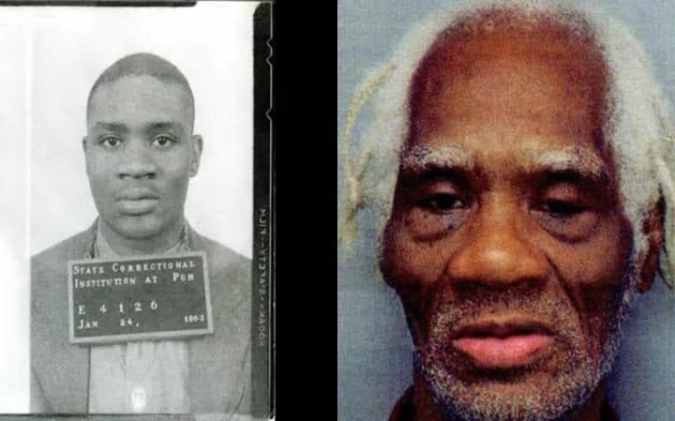
Joe Ligon before and during: at the time of his arrest in 1953, and snapped again in 2016, just before turning down an offer of parole.
As Philadelphia Inquirer columnist Karen Heller sums things up (Inquirer, 28 October 2016), his lawyer instructed him to plead guilty to murder, presumably to avoid a death sentence, and the resultant trial – for all five defendants and all eight crimes – lasted under a day. Jailed for life without the possibility of parole on 18 December 1953, at a younger age than any of the other inmates in this listing, and “trim and fit,” albeit with “but six teeth left in my head,” Ligon has long seemed more likely than anyone else to pass Geidel’s current U.S. record of almost 69 years inside. That will happen – if he lives and continues to refuse the parole he was offered in October 2016 on the grounds that it requires him to admit a guilt he strenuously denies – in August 2022, and he will then be 84. In the meantime, he works on as a janitor in the prison at Graterford. “I love to clean,” he says. “There’s no limit to it.” Which seems just as well.
-

Charles E. Wetzel, imprisoned in North Carolina, “evoked squeals of admiration from teenage girls because of his good looks,” charged the Raleigh News & Observer after his conviction.
South Carolina. Two fatal errors condemned Press Jacobs to the best part of a lifetime in jail. Estranged from his wife Carrie, and angered by “domestic trouble,” Jacobs – then aged 26, of Greenwood – went to her home in September 1951, armed with a shotgun and the intention to kill first her, and then himself. Instead, he “went blank” and murdered his sister-in-law, 17-year-old Virginia Rapp, before shooting himself non-fatally in the head. He recovered sufficiently to stand trial and had served 43 years in prison by the autumn of 1994, after which we lose touch with him. Jacobs would have been 69 years old by then (Greenwood Index-Journal, 15 Apr 1952).
- South Dakota. The obnoxious Howard Christensen did more time in the South Dakota system than anyone before or since; see above.
-
Tennessee. James Slagle began his sentence for murder in June 1968, and he remains inside today, almost 49 years later, having outlasted eight presidents and even the prison he was incarcerated in – Tennessee’s remote Brushy Mountain facility, which closed in 2009. It’s not for want of trying – Slagle once made an ingenious escape by “practicing yoga until he could fit into an 18 inch by 18 inch box,” which other inmates loaded onto a mail truck heading out of the facility. Unfortunately for him, he ran into a guard out hunting in a nearby forest and was rearrested. Now 79 years old, he next comes up for parole in February 2018. In the meantime, he says, he has learned to “like himself again” thanks to an educational initiative that allows him out of prison on day release in order to attend college classes. (Chattanooga Times Free Press, 5 Apr 2009). [Note: Tennessee has had at least one prisoner who served a sentence roughly as long as Slagle’s, but his identity was concealed when his existence was reported in the 1994 survey of long-timers conducted by The Angolite, and I have not been able to establish his name or the reason for his incarceration. See table at the foot of this essay.]
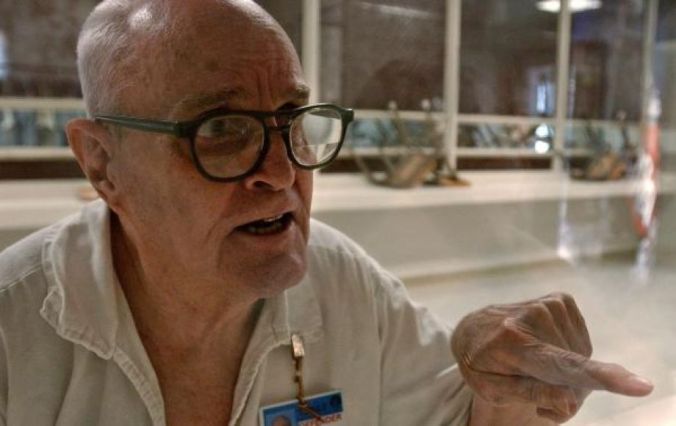
Harvey Stewart – convicted in July 1958 of the shooting of 26-year-old James Laird, he had already completed a lengthy sentence for armed robbery. “There’s no need to get carried away about it,” he said of his life sentence. “Have a fit. Go crazy. Hang myself. Stab myself. … There ain’t no need to be doing that.”
- Texas. Harvey Stewart, 83, who had specialised in robbing brothels, was paroled in very late in 2011 or early in 2012 after serving a combined total of 60 years for murder and several other crimes. Stewart, a violent and apparently unrepentant career criminal, spent 16 months on parole during this time (1985-86) before being returned to jail for conspiracy to commit bank robbery, and as such doesn’t qualify to rank among the longest-serving prisoners. As of 2014, he was “confined by law to a nursing home” and still attempting to get his 1958 sentence overturned. “Imagine that, sixty years down in this damn hole,” he told one reporter to went to see him. “I wouldn’t recommend it. Man’s got to be a damn fool to even stick his foot in here.”
-
Utah. The crimes committed by Utah’s longest-serving prisoners, two spree killers by the names of Myron Lance and Walter Kelbach, were brutal by any standards. The pair – cousins and lovers, both parolees – began by abducting, stabbing and shooting dead two teenage service station attendants, Steven Shea and Michael Houltz, on successive days in December 1966. Both victims were found naked on roadsides; they had died after first Kelbach, then Lance, won a coin toss for the “honour” of killing them, and each victim had been raped by both men before being killed. The total takings from the two murder-robberies was a paltry $300. Two days later, Lance and Kelbach murdered a taxi driver at Salt Lake City airport for a take of $19; about 30 minutes after that crime, the pair walked into Lally’s Tavern, took another $300 from the till, and opened fire on its customers; three died. Lance died, aged 69, in August 2010. Kelbach remains in prison, by now aged 77 and with 48 years served, having begun his sentence on 8 May 1967. Older Americans may remember his appearance on a 1972 NBC TV programme called “Thou Shalt Not Kill.” Smiling for the cameras, Kelbach announced: “I haven’t any feelings towards the victims. I don’t mind people getting hurt because I just like to watch it.” It seems wildly improbable that he will ever be released.
- Vermont. The Green Mountain State locked up Roy Girouard in January 1976 – and he’s still in prison there 41 years later, despite extensive legal wrangling over whether or not he qualifies for furlough. The state’s position is that he does not, since his sentence specified no minimum term. Girouard’s crime was to shoot dead another man outside a Burlington bar.
- Washington State. Robert Stroud – best remembered as “the Birdman of Alcatraz,” though his lengthy sentence took him to other outposts of the US prison system – served a total of 54 years for the murder of a Juneau, Alaska, bartender who had beaten a prostitute he pimped, and then a prison guard in 1916. Sentenced and first jailed in Washington because Alaska then had no independent judiciary, Stroud died, aged 73, in November 1963. The senior man in the Washington system today is Tony Wheat, jailed for the murder of three petrol station attendants in three different robberies. He went to prison in October 1965, escaped death by hanging, and is eligible for parole in November 2020. In the meantime, he serves on, and is now well over 50 years into his stretch. There are strange parallels between Wheat’s case and that of Nevada’s Richard Shuman; Wheat and his partner in crime, Arthur Aiken, were serving in the US Air Force when they set out on their criminal road-trip through the Pacific North-West.
-
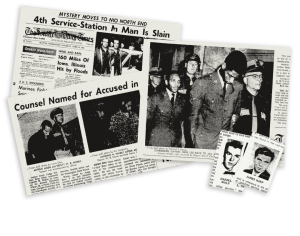
Washington State’s gas station killings saw Tony Wheat sentenced to death – then reprieved to begin a life sentence that has thus far stretched for 50 years.
West Virginia. William Holly Griffith, “once rated West Virginia’s leading badman,” in the words of the Charleston Gazette (15 July 1971), received not one, not two, but three separate convictions for first degree murder – in July 1915, April and September 1921 – and accumulated a reputation as a man so brutal that he was sometimes labelled “the bestial killer” in his day. Yet his attorney, J. Howard Holt, believed him to be innocent of most of the crimes that he was supposed to have committed. The man at the heart of these apparent contradictions was a farmer with only a third grade education who got himself into trouble with the law while living in Wirt County, WVa, in 1915. The infraction was only a minor one, but Griffith – described by one resident of the town as “a well-known desperate outlaw who will kill before he will submit to arrest” – apparently gunned down the sheriff sent to bring him in and then a railway policeman who caught him hopping a train, making it as far as Ohio before he was caught. Tried on the single charge of murdering the railwayman, Griffith was convicted on 16 July 1915 and sentenced to life in prison. In 1921, he and four or five other inmates contrived a well-planned escape, cutting the lights at Moundsville state prison and setting a fire to distract attention. Amid the confusion two things happened: a trusty was stabbed to death in the prison’s engine room, and Griffith got away, alone, dropping down a 30-foot wall to make his escape. Three further killings were ascribed to him while he was on the run, two of which happened more or less simultaneously 100 miles apart, and the third of which involved the murder of a boatman in Ohio. When Holly was eventually picked up, fast asleep in an empty house in South Carolina, he was tried for the killing of the trusty and the boatman. He took the rap for the prison killing, though there were always considerable doubts as to whether he really was the man responsible: “These other men are here for a few years and I am here for life – it makes no difference to me,” he told one visitor. Much the same lack of care for his own future seems to have marked his final trial, for the boatman’s murder, at which he offered no testimony or witnesses in his own defence. Thereafter, Griffith seems to have become a model prisoner; he taught himself tailoring, and by the 1950s was running his own clothing manufactury at Moundsville – successfully enough to accept contracts to produce uniforms for the state police and to be worth $40,000 real dollars. There was a late flourish, however; freed from prison on a temporary “medical respite” order so that he could seek treatment for cancer, he instead hired a car and set off on a tour of the United States with an old prison buddy, making it as far as the west coast. Griffith voluntarily handed himself back in after the tour, and died of cancer on 10 July 1971, six days shy of completing his fifty-sixth year in the pen.

William Holly Griffith before and after: pairs of mugshots taken at the time of his arrest in 1915, and after 44 years inside. Griffith went on to serve a further 12 years before dying, still in jail – though not before contriving a road trip to the west coast.
- A second West Virginian case is of some interest. Freeman Collins went to jail on 15 August 1930 for the axe murder of Perchie (or Percy) Jarrell, a man he claimed had killed his father 11 years earlier. Incarcerated in the West Virginia pen at Moundsville, he briefly escaped in 1965, was paroled in September 1972, and claimed a second victim, at the age of 78, when he stabbed his parole officer, Pauline McDowell Stuart, to death in August 1977 – apparently because she had refused to help him get to hospital after a motor accident. “He’s been a model inmate, but makes a lousy citizen,” was the verdict of warden Donald Bordenkircher. “He had a chance of freedom and went out and killed again.” Interviewed in 1986, nine years into his second stretch, Collins professed himself relatively content. His seniority had earned him the right to collect midnight snacks from the prison kitchen, and, he said, “I’ve got plenty of friends here, and we’ve got good doctors, good nurses, good guards and good food.” If freed, he added, he’d “go back into some coal hollow and build me a log cabin. I’d find me a woman who can cook cornbread, and I’d come to town only once a week.” He never got that opportunity. Collins served 42 years for the killing of Jarrell, and was 16 years into his sentence for the murder of Stuart when he died, at Pinecrest Sanitarium, Beckley, WVa, on 5 May 1994, at the age of 96. Together, then, his two killings cost him 58 years of his life.
- Wisconsin. Matters took a turn for the worse for Wisconsin prisoners during the 1980s – as they did for inmates in much of the United States. Prior to that date, Harlan Richards notes in his Wisconsin Lifers blog, successive state governors “routinely granted clemency to lifers by commuting their sentences to 50 years or less. This allowed [them] to receive parole hearings far in advance of the statutorily mandated 11 years, 3 months,” and “it was so rare for a lifer to spend more than 20 consecutive years in prison that in 1980 there were only two prisoners with that distinction” in the entire state. Automatic commutation ended during the Reagan years, with the result that Garold Rheinschmidt has now served more than 57 years of his life sentence for murdering an uncle and an aunt. The shooting happened while Rheinschmidt was AWOL from the US Army and after a day on the family farm “during which everything went wrong,” the Milwaukee Sentinel (13 Jan 1960) imprecisely observed in its coverage on the day after sentence was passed.
Listing of record sentences served outside the U.S.
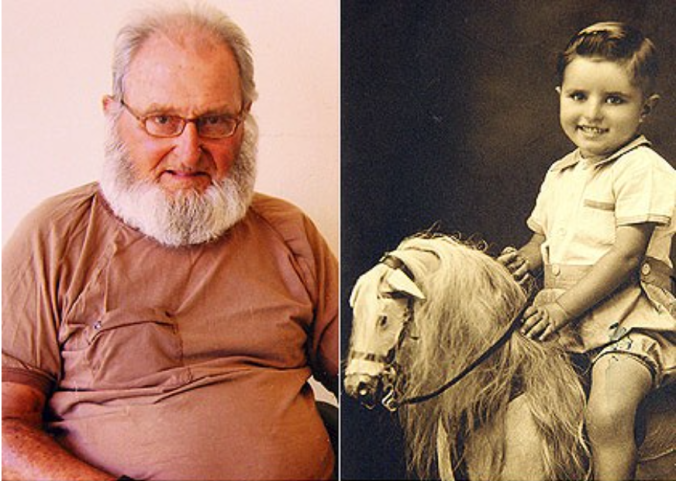
Tony Rawlins, after and before. As a lifer, more than 50 years into his sentence (left), and as a young child back in 1933.
- Australia. With the very notable exceptions of Charles Fossard and Bill Wallace, it seems that Tony Rawlins – who died aged 82 in April 2010 – was probably Australia’s longest-serving prisoner, and the man who served the lengthiest stretch in an Australian jail, as distinct from a secure mental facility. Rawlins was imprisoned in 1956, aged 28, for the “Kissing Point mutilation murder” and was 54 years into his stretch when he died. Rawlins had killed a child, strangling a 12-year-old girl named Fiona Pronger with his belt after she rejected his advances.
-
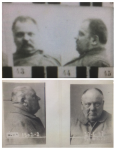
Søren Mathiasen before and after – in the early days and towards the end of his Danish record sentence.
Denmark. Søren Mathiasen served a sentence lasting 49 years and 180 days for the murder of a horse dealer whom he had engaged to find him a wealthy wife. Mathiasen, a farmer born on the Danish island of Funen, had been having trouble raising the 8,000 kroner he needed to purchase some land from his mother. After eventually raising the capital from a local fixer named Niels Bøgelund in the spring of 1876, he seems to have decided he needed a more secure source of funding. He returned to Bøgelund and agreed a larger payment in exchange for his help in arranging marriage to a “wealthy woman.” Whatever Mathiasen’s new bride brought to the marriage, it apparently didn’t consist of much liquid cash; Bøgelund pressed for payment for his services, and when Mathiasen could not afford to pay, he apparently decided on murder as his best way out. Big mistake. He ended up serving life with hard labour in Horsens State Prison, on the Jutland peninsula, where he was Prisoner Number 3 and where his story is now one of those told in the excellent new museum in the site. Mathiasen’s prison file shows that he always maintained his innocence of “strangulating, killing and poisoning” Bøgelund, and that by the end of his sentence – as the prison doctor wrote – “he now looks pale and lethargic… posture is stooping… his knees give way at every step. Likewise, his sense of taste and smell is almost gone…. Easy to get along with, but very listless.” Like Richard Honeck, the Danish farmer served a sentence that spanned a period of great change which almost entirely passed him by; one day, working in the prison garden, he saw his first car and – noted the prison’s Værkmeister, I.P. Jensen – became “very preoccupied with thoughts about these new carriages which are not drawn by horses.” Mathiasen’s sentence began on 27 June 1876 and ended – after a year-long spell in the Aarhus Hospital for the Insane – with parole on 23 December 1925.
- Eire. Jimmy Ennis has spent longer than any other prisoner in an Irish jail – 50-plus years for killing farmer George Applebe in the course of a robbery gone wrong. Ennis, now 88 years old, long ago earned the privilege of day release, but he has declined to seek parole for many years, and as of March 2013 was reported to be institutionalised and probably incapable of successfully adapting if released. According to Irish journalist Barry Cummins, author of Lifers, “If Jimmy Ennis applied for parole tomorrow, he would get it. But he won’t apply; he is institutionalised. He is more happy with his surroundings at Shelton Abbey, doing his gardening and odd jobs for locals and returning to prison at night.”
-

The Man in the Iron Mask – a fanciful depiction by Michel Moniquet. Contemporary descriptions of the mysterious prisoner suggest the mask he wore was made of velvet.
France. The longest sentences imposed in France date back to the country’s centuries of autocratic kingship. The Man in the Iron Mask – whoever he was – served 42 years, from 1661-1703, in several different prisons. Magdelaine (or Madelaine) Chapelain, a Parisienne fortune-teller who was implicated in the infamous Affair of the Poisons and arrested in December 1679 on charges of summoning demons, found herself entangled in a scandal so explosive that she was imprisoned indefinitely, without trial, using a legal device known as a lettre de cachet, which amounted to a royal command that could not be appealed. La Chapelain, as she was known, died in June 1724, aged 68, having spent forty four and a half years in confinement. More modern prisoners simply cannot compete with such ancient records; Philippe El Shennawy, released from prison aged 59 in January 2014, and apparently the recent record-holder, had completed 38 years of a life sentence for armed robbery and taking hostages. Life sentences in modern France do not normally exceed 30 years, but El Shennawy had been returned to prison after breaking the conditions of the parole he was granted in 1990, and had subsequently made two successful escape attempts, in 1997 and 2004. While free, he committed several further armed robberies.
- Japan. A one-time boxer named Iwao Hakamada was reportedly the world’s longest-serving prisoner on death row when he was released, in March 2014, after serving 48 years for the brutal murders of a family of four. He had maintained his innocence, and a reinvestigation concluded that the police had probably beaten the confession that he made from him, as well as fabricating evidence.
- New Zealand. Alfred Vincent was jailed in September 1968, aged 30, for indecent assault on five teenage boys, though he was suspected of having abused perhaps 95 more. Having failed the Kia Marama programme for the treatment of sex offenders on four occasions, he remains in prison. Vincent, who as of April 2017 had served 48 years, now has a glass eye, two hearing aids, and heart problems. Three of his four surviving victims support his release.
-

The crime scene left by Harry Roberts, an unrepentant career criminal who shot dead three policemen in west London in 1966.
UK. Ian Brady, the infamous Moors Murderer, is currently the UK’s longest-serving prisoner; he was jailed, along with his girlfriend Myra Hindley (d.2002), on 6 May 1966 for the abduction, torture and murder of five children in Manchester, and has intimated there were five more. Brady has thus completed very nearly 51 years in prison – much of it in secure psychiatric facilities after his diagnosis as a psychopath – and has acknowledged he should never be set free. His time served exceeded that of the almost equally notorious Harry Roberts, an armed robber who was paroled on 11 November 2014 after serving 48 years for the murder of three unarmed policemen who had stopped him as he sat in a car close to Wormwood Scrubs prison. The UK’s all-time longest-serving prisoner seems to have been John Straffen, who died in November 2007, still imprisoned, after serving 55 years for three child murders, one of which he denied committing. Straffen was aged 77 when he expired, though he reportedly had a mental age of about nine and a half.
Jouanna Thiec and the Huguenot connection

Marie Durand, a Huguenot martyr who served 38 years in jail for her beliefs during the 18th century. She is said to have hand-carved the word “register” – “resist” – into the walls of her cell.
In the course of researching this listing, I stumbled across a very odd claim that lurks in only a couple of obscure corners of the internet – for example, here. The claim is that a French woman named Jouanna Thiec served out a sentence of 73 years between the years of 1685 and 1758 – having been sent to gaol aged just 16 and been kept there until her release at 89. This, if true, would be enough to beat out her countryman, Charles Fossard, and place Thiec comfortably first in the all-time list of time served. But does this incredible story stake a credible claim?
First, the facts of the case, as they are supposed to be. Thiec, it’s said, was a late victim of France’s divisive and murderous Wars of Religion. These had ended in 1589 with the accession of a Protestant monarch, Henri IV, who converted to Catholicism in order to take the French throne after uttering one of the more memorable of all great historical quotes: “Paris is well worth a mass.” Nine years later, in an attempt to heal old wounds, Henri granted religious tolerance in France by issuing the Edict of Nantes. This guaranteed the surviving members of France’s Calvinist minority, the Huguenots, freedom of conscience, and the Edict remained in place until 1685, when it was revoked by the less tolerant Louis XIV.
Jouanna Thiec is supposed to have been one of the unfortunates who were imprisoned almost immediately after this revocation for refusing to renounce her faith. The only other detail that we have is that her “entire imprisonment was spent in a single stone cell 18×40 originally shared with over 30 other women, all of whom died there.”
Unfortunately, the earliest version of this story I can find is dated no earlier than January 2010. This seems odd. Thiec, had she existed, would have been a notable martyr to her faith, and there is an abundant French Protestant literature, much of it dating to the late nineteenth century, devoted to those who stayed true to their religion in the face of persecution by Louis XIV and his son, Louis XV. The best known of these cases involves a woman named Marie Durand, who went to gaol in 1730 and stayed there until 1768.

A modern painting, by Jeanne Lombard, showing Durand (arms crossed) and her co-religionists part-way through their sentences in the Tour de Constance in Aigues-Mortes.
How feasible is it that another Huguenot woman could have served a sentence almost twice as long as Durand’s, and yet been utterly lost to history? Thiec’s name appears in no book I’ve been able to find, nor is it mentioned on any credible website. I have found no reference to the members of any large group of Huguenot prisoners of conscience dying one by one in jail. Nor, most tellingly of all, does this case feature in an invaluable source that I stumbled across while seeking her: a listing, published in the sixth volume of the Bulletin de la Société de l’Histoire du Protestantisme Françcais, (1858) entitled ‘General notes of the persecutions against the Protestants of France.’ This covers sentences passed on French protestants for the whole period between the Revocation of the Edict of Nantes and the French Revolution, and includes a listing, several pages long, which gives the names of every individual inviolved.
Marie Durand is there, and one other notable case does appear: Jacquette Andabre and 16 others served 38 years in the castle of Carcassone, sentences equal in length to that served by Durand herself. But as there is no mention of a Jouanna Thiec, nor of any prisoner with a similar name, or noted as having served a similar sentence, it seems that this is one case that we can dismiss.
Summary (updated to April 2017)
The listing below summarises, to the best of my current knowledge, the longest prison sentences ever served by any prisoners, at any time, in any country. It ranks all prisoners known to have served in excess of 60 years.
§ denotes a prisoner who survived to be released.
† denotes a prisoner who was still alive and in prison at the time of the most recent calculations of time served, denoted by the date at the top of this summary section. Readers will need to recalculate the time served by still living prisoners by adding in time elapsed since the most recent update.
Clicking on names in mustard will link to further details of these cases.
INMATES WITH IN EXCESS OF 60 YEARS SERVED, As of 30 April 2017:
[1] CHARLES FOSSARD (Aus), 1903-1974. 70 years, 303 days (25,871 days)
[2] Paul Geidel (NY), 1911-1980. 68 years, 245 days §
[3] FRANCIS CLIFFORD SMITH (CT), 1950–. 66 years, 327 days †
[4] Johnson Van Dyke Grigsby (IN), 1908-1974. 66 years, 123 days §
[5] William Heirens (IL), 1946-2012. 65 years, 181 days
[6] John Phillips (NC), 1952–. 64 years, 287 days †
[7] CLARENCE MARSHALL (MI), 1950-2015. 64 YEARS, 70 DAYS §
[8] CHARLES FORD (MD), 1952–2016. 64 YEARS, 53 DAYS §
[9] Richard Honeck (IL), 1899-1963. 64 years, 44 days §
[10] HOWARD CHRISTENSEN (SD), 1937-2001. 64 YEARS AND <30 DAYS §
[11] BILL WALLACE (Aus), 1926-1989. 63 years, 148 days
[12] JOE LIGON (PA), 1953–. 63 YEARS, 133 DAYS †
[13] Oliver Terpening (MI), 1947-2010. 63 years, 125 days
[14] HUGH ALDERMAN (FL), 1917-1980. 62 YEARS, 192 DAYs
[15] WALTER BOuRQUE (NH), 1955–. 61 years, 140 days †
[16] WARREN NUTTER (IA), 1956–. 61 YEARS, 77 DAYS †
A note on methodology: [i] The start date of each prisoner’s sentence is taken as the date of his conviction, not the date of the crime he committed or the date of his arrest. [ii] The end date is taken as the date he was released, not the date that he was offered parole. [iii] The calculations make no distinction between continuous time served for a single offence or group of offences, and time served for multiple offences, so long as the prisoner in question served a single continuous stretch in prison. This means that it does include prisoners who committed additional crimes while in prison, and had time added to their existing sentences as a result, but it excludes prisoners who cumulatively served extremely lengthy spells in prison for different crimes, separated by periods in which they were free. [iv] I have not made any distinction between time served in prison and time served in secure mental hospitals – both are included, and prisoners who were transferred between prison and hospital are assumed to have served a single continuous sentence. [v] In cases such as that of Paul Geidel, where a prisoner was technically eligible for parole, but was not actually released, I have counted the additional time served. [vi] In cases such as that of Van Dyke Grigsby, where a prisoner was paroled and subsequently returned voluntarily to prison, the time served shown counts only the initial sentence served – it is not a cumulation of both the initial sentence and the time served after return to jail. [vii] In cases such as those of Frank Smith and Hugh Alderman, who both contrived escapes from jail, I have not deducted the time spent out of prison from the total time served. [viii] In cases such as that of Leslie Van Houten, who spent time out of jail awaiting a retrial that eventually reconfirmed her original sentence, I have not deducted the time on parole from the total time served, though in Van Houten’s case I would place Patricia Krenwinkel – convicted on the same day, but never paroled or retried – ahead of her in any listing of time served. [ix] In cases such as that of Howard Unruh – who never stood trial at all, having been diagnosed, controversially, with dementia praecox – I have made an estimate for “conviction date” based on the length of time the case was under deliberation by the authorities. In Unruh’s case, these proceedings reportedly took two months, so I have nominated 6 November 1949 as the date of the start of his “sentence”. On that basis, Unruh died 16 days short of reaching 60 years inside, although he had actually been in custody for longer than 60 years.
The listing is almost certainly incomplete.
Sources
Most of the material in this essay was sourced from old newspaper archives and lengthy trawls through Google.There were several special sources of information, though. US states now all maintain “Inmate finder” sites that are invaluable in establishing which prisoners are still incarcerated, where. At an early stage in the writing of this essay, I also uncovered a state-by-state listing of longest-serving inmates, compiled with the assistance of multiple Freedom of Information requests, which put me on to several of the more obscure stories listed here. This listing has since vanished utterly from internet view, but – thanks to my discovery of Douglas Dennis’s lengthy and groundbreaking article “The Living Dead,” published in the Louisiana State Prison’s prisoner magazine, The Angolite (September/October 1994) – I was able to fill in important gaps. The Angolite‘s listing (now well out of date, of course, and featuring only current prisoners in any case) is reproduced below. My grateful thanks to Germain J. Bienvenu, of Louisiana State University Libraries, for the considerable trouble he went to in obtaining it for me. Thanks, too, to commenters Edward Stengel and David Frigault for supplying tips and details of other fascinating cases.
The Angolite‘s survey of longest-serving prisoners by state, as of autumn 1994. Click to view in higher resolution.
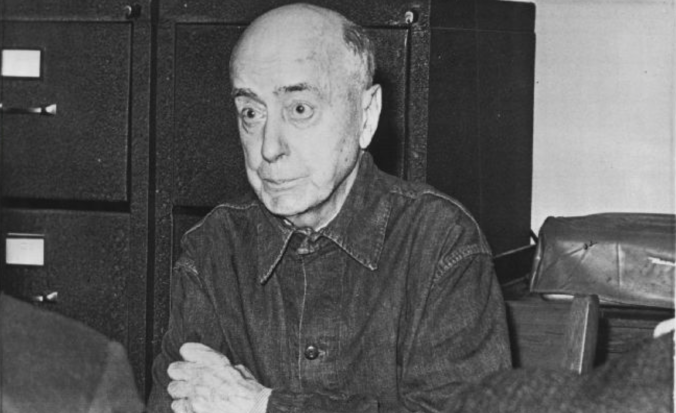
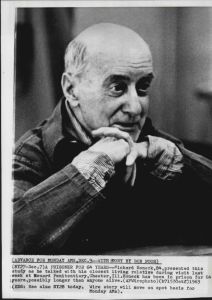

















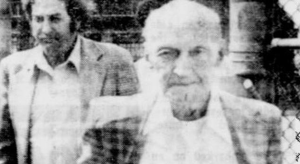


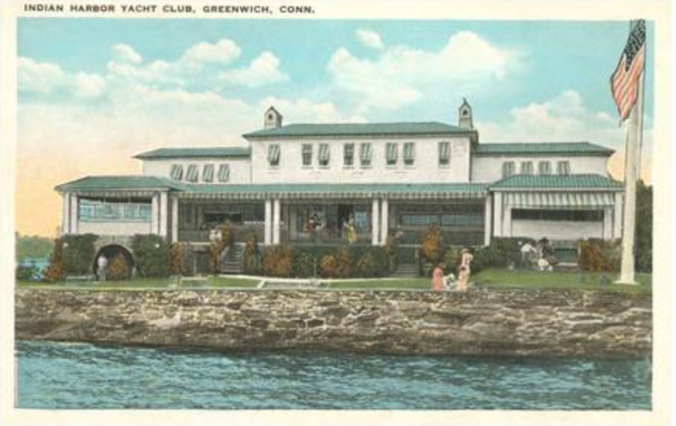

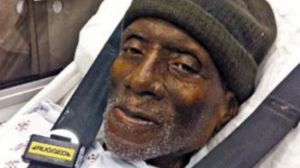


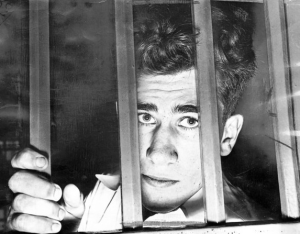

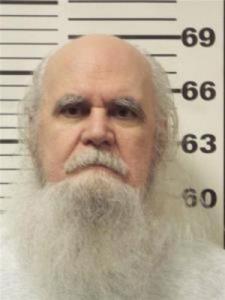
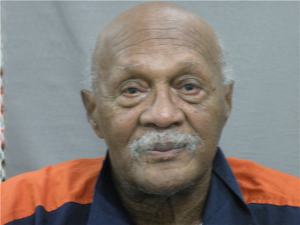


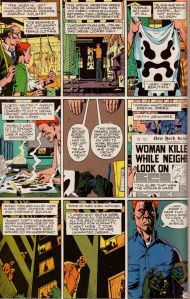
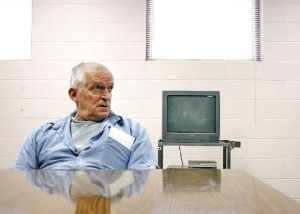
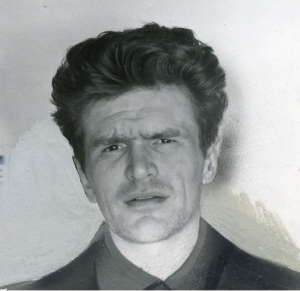





In South Dakota ,a young man murdered a girl and spent at least 59 years in prson he escaped the death penalty but got life with no parole Howard Christenson was the subject of a book ,59 Years by Pat Healy. Do you know anything about this I can’t find the book. Read about this in the Watertown Public Opinon newspaper in about 1993 Thank You , Sincerly, Frank McLaughlin ,The Villages,FL
Like you, I have not been able to find a copy of the book you mention. One was certainly being written, as of 1996, by State Rep. Pat Haley [Dem, SD], who was himself a former prison guard, but I can find no record of it actually being published.
I just came across this site, and noticed the comments about Ada Carey.
A community member here in Onida is working on a history presentation of Ada Carey for Thursday, June 2nd in Blunt. The Onida Watchman (local newspaper) is following the story and will publish details about the event in this week’s paper.
You can follow that story at http://www.onidawatchman.com, for anyone who is interested. There will be a story about the event this week (to be published June 1st) and a follow-up feature about the presentation and full story of Ada Carey in the Watchman on June 8th on the website.
Please leave a comment if you stop by the site 🙂 Thanks!
For those who did not see the Onida Watchman at the time, here is the story the paper ran in its 1 June 2011 edition. I will post the paper’s fuller retelling of the case, too, after 8 June:
Ada Carey murder retold in Blunt
By Amanda Fanger
Published: Wednesday, June 1, 2011 4:49 PM CDT
Paula Barber will be presenting a historical program about Ada Carey Thursday, June 2, to explain why the Eastern Star continues to hold memorial events in her name, 74 years after her untimely death.
“We want to get the story straight,” Barber said, adding that she wants to inform the general public about the history behind the name. “I want to answer the questions: why are we honoring her and what’s her story?”
Ada Carey was a school teacher from Blunt who was murdered in Sully County, just northeast of Onida, on May 21st in 1937. She was 26 years old.
As a teenager, Barber spent time studying and researching the Ada Carey murder case and feels that it is time to tell others about her findings; she wants to educate the newer members of the Blunt and Onida communities about the significance of the person Carey had been.
Barber is a member of the Order of the Eastern Star #86 in Blunt and adds that Carey had also been a member.
“I’d just been doing some research (on Carey) and suddenly thought, ‘oh my gosh! She was everything we advocate!’” Barber said. “I just felt that this was my personal project to do.”
However, Barber said that she just recently decided to host a public program. She said it all started when Joyce Bauer of Pierre inquired about the Ada Carey Memorial Easter Egg Hunt, which is held annually in Blunt.
Barber says, “I thought, ‘I’ll bet there’s more to this.’”
As it turned out, there was; Bauer’s mother was a past student of Carey.
Already, Barber says she has done “a lot of research,” but plans to dig up a bit more history from old newspapers before Thursday.
While this program is to inform new Blunt and Onida community members, she said, “There are people… who know exactly why we do this.”
To learn more about the 1937 murder case of Ada Carey, attend the program at the Blunt Senior Center on June 2nd at 8:00 p.m.
The first in a two-part feature in the Watchman, 8 June 2011, with the second part due on 15 June.
Clicking the link to Carey’s name takes you to a scan of the local Blunt Advocate for the week after the teacher’s death.
Ada Carey remembered
Amanda Fanger
On the morning of May 21, 1937, Ada Carey climbed into her car at Gettysburg and started for her home in Blunt. She had stayed the night with a friend, having just finished teaching for the year at Frankfort.
Little did the 28-year-old know that she would never make it all the way home.
Last Thursday evening, over 20 people gathered at the Senior Citizen Center in Blunt to reminisce about Ada Carey.
Paula Barber, advocate of the annual Ada Carey Memorial Easter Egg Hunt, addressed the audience, which consisted mainly of Eastern Star and Mason members and guests.
Miss Ada Carey, 28, was returning to her home town of Blunt that Friday morning, May 21st. She had been a school teacher in Frankfort for the past two years, and summer vacation had just begun.
Miss Carey had grown up in Blunt, the oldest daughter of Guy and Fanny Carey. After graduating from Blunt High School in 1927, she attended Huron College for two years.
Miss Carey had been described as, “one of the outstanding rural school teachers in the Blunt community.” She had taught rural schools in Sully County, also. She was a member of the Order of the Eastern Star #86 in Blunt and taught Sunday School, sang in the church choir, and coached girl’s class in physical education.
On Thursday night, Carey had stayed in Gettysburg after visiting friends there. At about 9:00 a.m. on Friday, she was traveling south on Highway 83 (then, the gravel road on the east side of Onida) when she noticed two hitchhikers walking on the side of the road. They looked to be about 18 years old, dressed in suits and cleanly shaven.
As she pulled over to give them a ride, Miss Carey had no idea that newspapers across the state would later describe her ‘brutal slaying’ at the hands of these very two boys.
“She was really a neat person that I wish I would have known,” Barber commented. “It’s good to bring (this) up again – she will not be forgotten.”
The second and final part of the Watchman‘s feature on the Ada Carey murder appeared in the paper on 15 June 2011. Here it is:
Ada Carey remembered – Part II
Amanda Fanger
Howard Christensen and Norman Westberg were young boys when they first met in a Sunday school classroom on the north side of Chicago. By many standards, the 16 and 17 year-olds were still young when they came to South Dakota, five years later in 1937, with the purpose and intent of leading a life of crime.
The boys had lived about a block away from each other and had both had run-ins with the law for creating mischief. Christensen had served six days on a juvenile court charge of “malicious mischief;” he had begun to repaint a house black after the owner had just painted it white. Both boys had also experienced charges for shoplifting.
Both youths were drop-outs, and, discontent with their jobs, they decided to set out on a crime spree. They developed a plan; travel to Seattle, Washington, and begin a pick pocketing school. They had gleaned the inspiration for such a school from a fiction magazine story about just such a school; enrollees were to be given two weeks to learn the art and if they failed for any reason, they would be “docked off.”
Christensen had been working for a printing concern in Chicago, complaining about not getting “good enough” pay, and Westberg had come back from the Civilian Conservation Corp after having served there for two years.
Westberg had sent a portion of his wages to his grandmother, Caroline Peterson, in Waupaca, Wisconsin while he had worked in the CCC.
The boys left Chicago May 15th and went first to Wisconsin to secure the money that Westberg had sent to his grandmother and was deposited in a bank there. The duo arrived on Saturday night and stayed until Monday morning when Westberg went to the bank to withdraw nearly $130 of the $400 he had sent to his grandmother.
The youth also stole a .32 pistol from the man whose house Westberg’s grandmother was housekeeper. Apparently in bad repair, the boys had the gun fixed at a local gunsmith’s before continuing on their journey.
They next bused to St. Paul, MN and bought new suits of clothes and spent time in pool halls. It was during this time that they discussed the possibility of holding up some lone traveler in an automobile. They finally purchased a ball peen hammer that Christensen carried with him while Westberg carried the revolver.
Christensen was to use the hammer to knock out their prospective victim.
The boys arrived in Watertown, SD on Wednesday night. At the hotel, they gave the names of N.F. Westberg and “Howard Winnan.” The second name was one they had taken from a Robert Ripley ‘Believe-It-Or-Not’ cartoon which they said meant, “courage, bravery and victory.” They registered as being from Fargo and paid for their lodging with a $20 bill.
According to the night clerk on duty, the boys had looked well dressed and older than their real ages.
During their stay in the Watertown hotel, the youth further detailed their plan for holding up a lone traveler. They agreed upon a signal which Westberg was to give his colleague, who would be seated in the rear, by folding down his second and third fingers while keeping the first and fourth fingers extended.
They were set to put their plan into motion on Thursday morning when they hailed a ride from an elderly man driving a Ford sedan. However, as Christensen was climbing in the backseat of the car, the handle of the hammer protruded from inside his shirt where the potential weapon was concealed. The man became suspicious and watched them closely, so no hand signal was given and the man dropped the boys off at Redfield at about noon. They caught another ride in a truck driven by a wool buyer to Gettysburg. The boys later explained that they did not move on this driver because they did not want a truck for their travels.
On Friday morning, after having stayed in Gettysburg, they decided again to try an altered plan; if possible, they would select a woman victim.
They caught a lift on a truck from Gettysburg out to the intersection of highways 212 and 83, about five miles west of Gettysburg. Highway 83 was then on the east side of Onida. The boys passed up several cars that they deemed ‘unsuited’ to their purpose, until they saw a shiny new car being driven by 28-year-old Frankfort school teacher, Ada Carey, who was traveling to her parent’s home in Blunt.
“This looks like our chance,” one of the boys remarked to the other, and they began hailing her. This was around 9:00 in the morning.
When Miss Carey pulled over, Christensen climbed in the back seat, as pre-arranged, and Westberg climbed in the front. After traveling for 15 or 20 minutes, Westberg gave the signal and checked that his partner was aware.
Suddenly, Westberg reached down and pulled the keys from the ignition, while pulling the gun out of his pocket at the same time.
“Why you…” Miss Carey said and as she reached for the gun, the car began to lose speed. Westberg fired the pistol, and it seared Miss Carey’s hand. At the same time, Christensen leaned forward from the back seat and hit the girl over the head with the hammer which he had concealed within his shirt. Miss Carey then reached for the door handle and attempted to escape the car, but Westberg shot again, hitting her in the back, below the right shoulder.
By this time, the car had turned into the ditch, and Miss Carey fell from the vehicle. The boys picked her up and loaded her into the back of the car, although she pleaded with them to be left where she was. The placed her on the floor in the rear of the car and covered her with their own luggage. Westberg got behind the wheel to drive while Christensen sat beside him in the front seat.
As they were driving, Miss Carey partly rose off the floor, and Christensen hit her over the head with the hammer once more. Westberg didn’t pay enough attention to his driving at this time and went into the ditch again.
Getting out and going again, the boys then noticed another automobile following them and became nervous. At this point, Westberg again lost control of the car and it entered the ditch again and the car flipped over on its top.
The boys, uninjured except for scratches and Westberg’s sprained wrist, took off running across the open country after the car came to a stop.
Frank Hiatt of Huron had been following the Chicago youths in Miss Carey’s car for several miles and witnessed the wreck. Hiatt stopped at the crash site and found Miss Carey there, who told him she had been shot. Not wanting to move the girl, Hiatt went to a nearby farm and retrieved a farm wife to stay with the girl while he traveled on to Onida for help.
Newspaper’s account said that a Dr. V.W. Embree accompanied Sheriff Jack Reedy to the scene and brought Miss Carey to town. Sully County State’s Attorney Francis M. Ryan took a statement from Miss Carey at the hospital, which included a description of the boys.
Meanwhile, a posse was organized to search for the youths who had shot Miss Carey. It is said that “large crowds gathered in town by noon” from Blunt, Agar, Gettysburg, and Onida.
The youths were found hiding in a patch of Russian thistle a few miles north of Onida about three hours later. Accounts tell that the men who found them weren’t sure at first that the youth were hiding among the weeds, so they called out. The two boys jumped up and began running. Christiansen stopped upon the order of the men, but Westberg continued running until a couple of shots were fired over his head.
Newspapers from that time period described Christensen as “tearful and apparently very sorry for his act, according to officials, but since that time has given very inconsistent answers to the questions asked him by officials.” It was later said of Christianson that his mind never developed past that point.
The boys were brought before Miss Carey just prior to her death, and she was able to identify them.
Headlines of newspapers across the state following Carey’s death called it a brutal slaying and the worst in the history of the state.
“The fact that the boys had started out planning on just such a career makes it obvious that no punishment can be too severe for them, and that they have no rightful place mingling with society,” stated one newspaper editorial after the boys were caught.
At that time, South Dakota did not have a capital punishment, although a life sentence was mandatory for murder. Two weeks after Miss Carey’s death, the boys were arraigned and sent to the State Penitentiary in Sioux Falls to serve their life sentences.
Several years later, Westberg hung himself while Christensen died of old age a few years ago.
Miss Ada Carey had been a member of the Blunt Eastern Star and in 2001, the annual Easter Egg Hunt was renamed in her honor. Paula Barber had made the connection to the crime committed north of Onida and the Eastern Star.
“I thought it was so interesting,” Barber said. “We (renamed it) because she possessed so many qualities that the Eastern Star advocates.”
Two weeks ago, Barber held a public historical program in Blunt to highlight the events of Carey’s murder.
“It’s good that we’re getting reacquainted with our roots,” she said. “I feel kind of good that we uncovered this again.”
Thanks for this site and for your hard work….
Mike,
I just found your blog and am SO glad I did. I read Batavias Graveyard when it first came out and loved every page of it. We seem to have the same kind of fascination with history and how mankind was able to endure and experience things that today we can only imagine. I have a fascination with geography, exploration etc. The Fatal Shore by Robert Hughes is still one of my favorites.
Thanks again,
Chuck Halverson
Saint Paul, Minnesota
“The Fatal Shore” is an awesome read. One of my all-time favorites on the subject of crime/punishment
I’m glad this article is still accepting comments. Concerning the longest incarcerated prisoner in United States history, it should be considered Johnson VanDyke Grigsby, who spent over 66 years in the Indiana state penitentiary, from where he was paroled in his late ’80’s around 1975. He met John Dillinger there. William Heirens, who spent a little over 65 years in prison, having died this year, 2012, was second. Richard Honeck should be considered the 3rd longest serving inmate, having served 64 years. In the case of Paul Geidel, even though he spent 68 years in confinement, it was partly in mental hospitals, so it wasn’t all imprisonment. As long as we’re talking about mental hospitals, we should give honorable mention to Howard Unruh, who spent 60 years in New Jersey mental hospitals, after having committed what was considered to be the first mass shooting murder in modern post World War 11 America, when on September 15, 1949, he shot 16 people in Camden, New Jersey, 13 of whom died. He recently passed away at age 88 in the New Jersey state mental hospital. 2 got out – Grigsby and Honeck, and 2 died in confinement – Heirens and Unruh.
Honeck was 20, he was born on January 5 1879 and was arrested in September 1899. One question, was he tried by the state of Missouri or Illinois? Because it says his hometown was in Missouri but he was in an Illinois prison.
I don’t know the old laws of Missouri since their information is scant, but I do know the reason the state of Illinois called life, “Life Imprisonment” was for a different reason than it is today. Unlike today where life in Illinois is without parole, until 1978 life in Illinois meant parole after 11 years.
I know of other people who beat Honeck’s record since. One was a 21 year old named Johnson Van Dyke Grigsby who after a poker bar fight, went to a pawnshop and bought a knife and got into another fight with the same person resulting in the other being stabbed to death. He did this in 1907 and was convicted of 2nd degree murder in 1908 and sentenced to life in prison and sent to the Indiana state penitentiary where he stayed until being paroled in 1974 at the age of 89 and spent the rest of his life in a nursing home, dying in 1987 at age 102.
It is remarkable how a few people managed to spend 60 years or more in prison when comparing that an average life sentence for a capital offence at the time was 7 years and as far as I am aware none of the ones I mentioned were convicted of capital murder.
Today Louisiana is the harshest jurisdiction on average with the sole possibility of the Federal government. Before 1973 however life in Louisiana meant much less than natural life. Before the 1870’s the penalty for murder was either death or a certain number of years, generally 15-30 years though sometimes less or sometimes more. However unlike in most states of today, most offenders could receive parole in their sentence. In Louisiana parole came after one third of their sentence was completed. This means a prisoner sentenced to 15 years could still be released within 5 years on good behaviour.
In the late 1870’s Louisiana began introducing life sentences where a lifer became parole eligible after a minimum 5 years. However in the early 1890’s a law was enacted to the governor stating except under exceptional circumstances that a lifer could not be imprisoned for more than 15 years. In 1913 Louisiana abolished parole for lifers however life was never mandatory at the time. However unlike the modern lifers who tend to only get out under mitigating factors or terminal illness, and usually after decades in prison, the lifer in Louisiana in those days was paroled after serving an average of 10 years and 6 months by the governor, (and most lifers in Louisiana at this time were in for capital murder, some even being taken off death row prior to getting life.)
Then in 1973 the laws changed almost overnight. Suddenly a mandatory life without parole sentence was imposed on all convicted of 1st degree murder after introduction of this sentence, and then ordered all 2nd degree murderers serve a minimum 20 years of a life sentence, then in 1975 the law said 2nd degree murderers must now serve 40 years and on July 14 1979 the state of Louisiana said all life sentences from now on would be without parole. This means the only parole eligible lifers in Louisiana now are a handful of 2nd degree murderers who committed their crimes between 1973 and 1979, the only time since 1913 where life sentences came with the possibility of parole.
Another state that is notorious for their harsh penalties when it comes to murder is Pennsylvania. In Pennsylvania life imprisonment without parole is mandatory both for 1st and 2nd degree murder just as Louisiana (a third state mandating life without parole for both degrees is South Dakota however at this moment I am not certain when they enacted these laws.)
Pennsylvania had abolished parole for life sentences in 1941 however it did not remain a mandatory sentence. The handful given life did not serve a real life sentences in the vast majority of cases. An average life sentence in Pennsylvania up until the 1970’s was 12 years before receiving a pardon from the governor.
Though the Federal Government has always had Life Without Parole as a sentencing option, in reality it was rarely imposed, then in 1913 they said all life sentences now came with parole after 15 years, the only exceptions would be if a person on death row had his sentence commuted to life and a judge refused to give parole. Until 1979 the Federal Law Books dictated that life officially meant 15 years, then it was increased to 25 years and then to natural life on December 1 1987.
Until the Reagan years Presidents were known to pardon hundreds, sometimes thousands of Federal prisoners in a single term, though the amount of pardons declined starting in the 1950’s, the average life sentence did not increase by much since there were many pardons done by the Courts.
It is also much harder to get a pardon out of prison than it was in the old days. Before the tough on crime laws started to escalate in the mid 70’s, most prisoners including those serving sentences for capital offences could receive day parole. Meaning they could go to work outside of prison or go to school, some even owned their own cars which they could use to drive from and back to prison.
In most states until recent decades parole for a life sentence came after 7 years. However in practice releasing people after 7 years began to decline starting in the late 70’s to early 80’s and by the mid 90’s had become a thing of the past, especially for more serious offences.
The statistics of 1990 say a life sentence had by this time increased to a national average of 21 years and risen to 29 by 2003. However unlike the days before the lock em up policies, there were much fewer lifers, most being in for murder or other serious offences of that nature. Now over a third of lifers are in for non-violent offences such as burglary, drug offences, shop lifting, drug trafficking etc., The lifer population has also increased dramatically. For example in Louisiana in 1970 only 143 prisoners were serving life sentences, and at the time a lifer could usually expect an eventual pardon from the governor. By the late 1990’s the lifer population in Louisiana had risen to over 5,000, now it’s nearing almost 9,000. This also doesn’t count the fact that Louisiana also has a big amount of virtual lifers. In the Louisiana State Penitentiary from what I last heard of 5,100 prisoners in the prison, 2,000 were serving sentences other than life such as 90, 120 or 150 years. Few can complete their sentence in their lifetime, many will not make it to the parole board hearing, and most that do will never get paroled.
The state of Florida abolished parole for 2nd degree murderers in 1983 and mandated they serve all 20 years or a minimum of 25-30 years for any crime resulting in the discharge of firearms. That same year they mandated all lifers for 1st degree murder would now have to serve a minimum 25 years before becoming parole eligible. In 1996 the state of Florida abolished parole completely for those sentenced on 1st degree murder charges after the date of the new laws.
In the state of Arizona the average life sentence use to mean about 13 years, then in 1978 the law was changed to say lifers sentenced for 1st degree murder must now serve a minimum 25 years. The average life sentence was the same in Wisconsin where parole came after roughly 11 years in most cases, however there were cases of some getting out after the mandatory minimum of 5 years. Back in the early 90’s there were only 2 lifers in Wisconsin who had served over 20 years in prison, one of which was there voluntarily, then by 2006 it had increased to 255 now it’s nearing 450. Of all the lifers in Wisconsin sentenced after 1989, only 2 females have been paroled.
The reason for longer sentences had little to do with crime rates. In fact crime rates had been falling since 1967, several years before the draconian laws came into place, and ironically briefly escalated in the late 80’s before declining again in the early 90’s.
In the state of Michigan most lifers got pardoned by the governor. Then in 1942 they officially declared in Michigan that a lifer become parole eligible after 10 years. It was not until 1978 that Michigan changed the laws. Suddenly Life Without Parole became the mandatory sentence for 1st degree murder and 650 grams of coccaine under the “650 Law.” Those convicted of 2nd degree murder would receive parole after 15 years. In 1998 Michigan allowed parole for those convicted of the 650 grams law however of the hundreds sentenced under this law, only six have been released at the time of writing.
Other states like North Carolina abolished parole in 1993. In 1995 only 16 states had Life Without Parole in its law books, by 2009 all but Alaska had it (however it should be clarified that Alaska does impose sentences of 99 years), the latest three states to introduce it were Texas, Kansas and New Mexico respectively. Texas introduced the sentence in 2004, however on September 14 2005 Life Without Parole became mandatory in this state for capital offences, before this law, the maximum penalty in Texas other than the death penalty was 40 years to life, same as Kansas which had it for murder with aggravating circumstances, other lifers convicted of murder in Kansas received sentences of 15 years to life before introducing the sentence in 2008 however just like a handful of other states like North Dakota, New Mexico and New York rarely impose the sentence.New Mexico introduced the sentence on August 1 2009. Those given life without parole are the ones who would have received a possible death sentence prior. New Mexico like Connecticut did not abolish the sentence retroactively, therefore those on death row or who committed their crimes before August 1 2009 can still receive death, however at the time if given life a lifer in New Mexico became parole eligible after 30 years, now they must serve a mandatory Life Without Parole for the same crime.
The amount of people serving virtual life sentences is also much higher than what it used to be. Some sources say it is nearly one hundred times higher than it was in the 80’s, most of these people serving consecutive sentences for non-violent crimes, some such as Sholam Weiss are serving 845 years for stealing money. Others like Jeffery Kolli and Russell Brandt are serving 7 life sentences plus 265 years for robbing seven houses and restaurants. This is the longest life sentence in Georgia’s history by over 50 years, what is interesting to note is they were sentenced in August 2006. Until January 1 1995 all life sentences in Georgia came with Parole after 7 years.
Back in the 1970’s less than 25,000 people across the USA were serving actual life sentences and the prison population was several times smaller per Capita than it is today, those serving Life Without parole were almost non-existent. By 1995 with more states introducing longer life sentences, the lifer population rose to 50,000 with 10,000 serving life without parole. By 2003 it had risen to over 140,000 with nearly 40,000. Now the lifer population stands at nearly 180,000 with approximately 50,000 serving life without parole sentences. It is interesting to note that as the lifer population increased, so did the percentage of those serving life without parole.
Though the average time of a released lifer is after 30 years, it should be noted most lifers today do not get paroled, in fact in 6 states, Louisiana, Maine, South Dakota, Pennsylvania, Iowa and Illinois as well as the Federal Government all life sentences are without parole. In 22 states an average of 10 lifers out of thousands of applicants get released from each state every year, most for non-violent crimes after serving decades in prison. In the state of California out of 5,000 lifers who applied for parole in 1995, the parole board only accepted 48 however the Governor revoked all but 1 approval.
As noted the lifer population has gone up. In 26 states Life Without Parole is mandatory for 1st degree murder and mandatory for 2nd degree murder in South Dakota, Louisiana and Pennsylvania. The interesting thing to note is on average states with a death penalty have a lower mandatory minimum sentence than states without. South Dakota and Pennsylvania have only executed people voluntarily yet have the most strict 2nd degree murder laws other than Louisiana, while states like Texas, notorious for their executions usually allow murderers to become parole eligible after 20 years. In the state of Virginia which holds the 2nd highest execution rate at 109, most convicted of 1st degree murder in this state are eligible for parole after 15 years.
I could go on further but I think I made my point that life sentences are significantly longer than they were decades earlier and is much harder to be pardoned when out of prison, and unlike most states which force prisoners to have careers making license plates or pick garbage on a desserted highway where a car goes by once a week, in the old days prisoners could have normal professional jobs, sometimes working outside prison as lawyers, engineers, chefs, a few even became doctors while in prison.
By the way to anyone who knows, does anyone know what happened to Richard’s accomplice? How many years did he serve, and did he get released and does anyone know what happened to him?
Thank you for that remarkably comprehensive comment – probably the longest on the site. You certainly deserve an answer to your questions. Herman Hundhausen successfully convinced the jury that Honeck had wielded the knife that killed Walter Koeller and that he was merely an accomplice. He was sentenced to 20 years, to be served in the same prison, Joliet, that Honeck was originally incarcerated in.
Although Honeck and Hundhausen came from Missouri and committed their early crimes there, the Koeller murder was committed in Chicago and the pair were arrested and tried in that city, which explains how Honeck came to serve his sentence in Illinois (and perhaps helps to explain the remarkable paucity of Honeck’s visitors).
I came across an interesting article for you and anyone interested in the Johnson Van Dyke Grigsby case. The article is short but tells the story of how he went to prison and though he was technically paroled in 1974, after 17 months in a nursing home he went back to jail on his own because he said there were no jobs for him. This means he spent about 11 more years in jail to his already 67 years in prison (66 of which were in the Indiana State Penitentiary) giving him a total of about 78 years and some months. Had he never been paroled he would have served over 80 years in prison all together.
http://news.google.com/newspapers?nid=950&dat=19760909&id=c_gLAAAAIBAJ&sjid=mFgDAAAAIBAJ&pg=5186,1869151
Can you imagine going to prison and getting out in 2081? The world will be completely different, even more so than this guy’s world, due to the rate of technology advancing.
Reading further on, it seems two black panthers served 40 years (!) of SOLITARY CONFINEMENT.
Can’t imagine what that would do to a person’s mental state. I’d be more worried about letting them out. 40 years, wtf
Excellent read! Comments overall equally fascinating.
Nice job, Doc.
Thank you, Rich. I appreciate this and all the other positive comments you’ve left here and at Past Imperfect. I’m glad to hear that you enjoy the sort of things that fascinate me.
I really like looking through a post that will
make men and women think. Also, thank you for allowing me to comment!
Pingback: Top 10 world records no one would really like to achieve - Listmellow
Pingback: America’s first highjacking | A Blast From The Past
Pingback: The Longest Prison Sentences Ever Served - HistoricalCrimeDetective.com
Pingback: The longest prison sentences ever served: redux | A Blast From The Past
Pingback: Charles Lucas Edmond Kindel Sidi Foussard: Detained During the Governor’s Pleasure … for 70 Years and 337 Days. | aradale book project
Hey Mike – Chopper’s characterisation of J Ward is somewhat sensationalised. However, J Ward was an old Pentonville-style gaol (sorry, JAIL) before it was “converted” into a psych ward: it certainly wasn’t the Ritz. Great blog, btw …
I want to congratulate you on the time and effort that you must have spent on compiling this list. I have been doing some historical research on a topic for 15 years, and a couple of those years were 1 day a fortnight going down to the State Library of NSW in Sydney, Australia and scrolling through the microfilm copies of old newspapers for relevant press reports, so I can understand what you have done. Would you be able to guess how many hours you spent looking at old press clippings for this blog post?
Getting back to the article:
” He and another man, Herman Hundhausen, had gone to Koeller’s room armed with an eight-inch bowie knife, a sixteen-inch bowie knife, a silver-plated case knife, a .44 caliber revolver, a .38 caliber revolver, a .22 caliber revolver, a club, and two belts of cartridges.”
That is an awful lot of weapons to be carrying around to murder just one man!
Thank you, Graham. The research put into this essay doesn’t really bear thinking about. I know it has taken me three and a half days of solid work to complete this year’s update – a big one – so I suppose maybe 120-150 hours of research total would be a reasonable estimate. Of course, it’s only as little as that because of the advent of keyword-searchable newspaper databases – the work would have been simply impossible a couple of decades ago. I’ve done my share of microfilm-based newspaper research and it’s the toughest thing I’ve ever had to do as an historian – especially the Victorian-era stuff with no photos or headlines to help, and dense print in 6-point type…
It’s worth it to complete a really useful database that has no parallel elsewhere, though.
Like you, I found my jaw dropping at the arsenal Honeck and Hundhausen assembled. I’m tempted to say it shows that they must have really hated Koeller, but I’d guess the truth is that they were also a pair of immature, inexperienced boys who had no idea of the real consequences of their actions.
This scares the shit out of me. How could you possibly comprehend the changes going in to jail in 1900s and coming out in the 70s or 80s?
That’s the closet thing to space travel?
For Sweden the record is assumed to be 67 years, a woman named Anna Lindersson was locked up in an assylum starting 1893 up to her death in 1960, she never had a single visitor in those years.
For accumulated time the record is probably held by pedophile Sten Erik Eriksson who has spent close to 70 years locked up in total, first locked up in 1945 for sexual relations with boys aged 14, then released in 1948 aged 17. Then he was again locked up in 1949 for sexual relations with boys, then released in 1957 after being sterilized, then he was again sentenced in 1958 for sexual relations with boys, released in 1966. Less than half a year later he commit a rap-murder on a 8 year old boy and is sentenced in april 1967 to psychiatric treatments where he still remain as of february 2017. He is 85 years old and still considerer too dangerous to be released.
Thank you very much for writing in about Anna Lindersson – I had not come across her case before.
I’ve now read through the small amount of information that’s available about her case online. It’s frustrating that almost nothing is known about the reasons why she was incarcerated in the first place. There does seem to be no indication, though, that she was subject to any criminal proceedings so after a fair bit of consideration I have decided not to add her to the prisoners’ listing.
I think she does deserve to be remembered, though, so, for English-speaking readers, here is a short summary of her case:
Anna Lovisa Lindersson was born in Stockholm on 10 October 1872. She was sent to Piteå Hospital (later renamed Furunäset Hospital), an asylum in northern Sweden, just inland from the Gulf of Bothnia, which took in patients from across northern Sweden and Norway (then and until 1905 a province of Sweden) and could hold up to 300 patients. The asylum was for incurable cases and offered electro-shock therapy, so-called “long baths” and, from the 1930s, lobotomies. It was popularly known as “Piteå-five-five,” after the local telephone dialling code (supposedly – another theory is that the numbers are a reference to the Swedish penal code), and was sufficiently well-known – or notorious – in Sweden for “five-five” to become a popular term for the mentally ill.
Lindersson arrived at Piteå in 1893, shortly after the facility opened, as one of the first batch of patients sent to be confined there. She remained in the asylum until her death on 16 April 1960. Thus far, none of the writers who have discussed her case have established exactly why she was sent to the hospital or why she was considered incurable.
If your blog posts weren’t so interesting (and, evidently, well researched), I wouldn’t comment 🙂
You mention Honeck was born in 1879, but arrested at the age of 22 in 1899. It doesn’t quite add up, does it? Do you know, which of the dates is more uncertain?
Please keep up all the good work,
cheers
You’re absolutely right. He was 21. Thanks – corrected.
How ironic that these men are remembered here and few, if any, that read this will be.
This guy Honeck went to prison BEFORE powered flight existed in any real form and then gets to fly home… Mind fuck of note..
According to the Southern Poverty Law Center, Roosevelt Youngblood died in “early 2004” of cirrhosis. https://www.splcenter.org/seeking-justice/case-docket/baker-v-campbell
Thank you for the update, I appreciate it. I’ll make an edit to the relevant capsule summary.
great reads; this site is a Favorite, always interesting (if not somewhat depressing). So far, I’ve learned via your writings, much of what I hope to avoid first hand. May this long continue.
Had the pleasure of meeting Mr. Grigsby as I worked at the nursing home is was staying. I remember him giving me a nickel for a loaf of bread and not having the heart to tell him the actual price I just made up the difference.
I WORKED AT ISP IN 1976 AND NEW THIS OLD MAN. HE WAS ALWAYS TELLING STORIES ABOUT THE GANSTERS THAT WERE LOCKED UP THERE, HE SAID THEY WERE A BUNCH OF PANSIES, EVERY ONE.
My great uncle is Albert Paul. The last of his siblings just passed away last winter. My father had a ship enclosed in a glass case that the inmates had made. Albert had given it to my grandfather (his brother) and my grandfather passed it onto my dad who in turn passed it on to my brother. It only holds sentimental value because my grandfather passed it on. Such disdain in this family for that man. ……from what I understand it was a rough upbringing. His mother passed just after he was born …out of 11 or 13 children. Not sure the count right now without digging back thru the ancestry stuff. He was shuffled off to live with other relatives, his father was going back and forth between Canada and USA. I believe all the brothers and sisters were grown and on their own except one who was young and went to live with an aunt. Interesting read tho. He was on an episode of ” I almost got away with it” on the ID channel last June.
I am struck that almost every one of these lengthy sentences occurred in the United States, which also has the greatest number of incarcerated people in the world.
An excellent post! Very interesting and well researched.
Since the latest update, the Moors murderer, Ian Brady, has passed away. He died of heart disease on May 15th, 2017.
Thanks, Linus. You’re absolutely right that we need to do another update of the list. The resource has become a little unwieldy, though, and I am going to have to wait till the end of the year to produce a proper update of the entire thing. I’ll correct the Brady listing at that point.
Pingback: These Men Lived To Be Released After Serving Some Of The Longest Prison Sentences Ever – Facts WT
Your entry on Booker T Hillery needs updating.
He got his retrial in 1986. The police rechecked the forensic evidence and proved beyond any doubt that he was in the home and thus was the murderer.
Pingback: Top 10 Scary Inmates Who Have Served The Most Time In Prison | Host your Website
Pingback: Top 10 Convicts Who Outlived Their Life Sentence – Part 2 | Host your Website
Pingback: Top 10 Convicts Who Outlived Their Life Sentence – Part 2 – Charlie Likes Online
I really don’t feel too sorry for those people who were or are incarcerated for a very long time. As you know, if you can’t do the time, don’t do the crime.
Walter Bouquet, prisoner from N.H. is in fact still incarcerated. He resides in MCS. Is a c3 inmate (gp), and still works in industries. He will talk to anyone, just bring some chips.
Pingback: Discord